Introduction
HWLabs Nemesis 140 GTX Radiator Review
Welcome to another Extreme Rigs review. Under the spotlight today we have another 140mm radiator. This time it’s the Nemesis 140 GTX from Hardware Labs. The Nemesis GTX series is touted as the flagship performer of the HWLabs range so we are keen to see how this 140mm version performs in our thermal testing.
HWLabs have been kind enough to supply review samples for all our radiator reviews so far. So a big thank you to the crew at HWLabs for their continued support.
Before we start we would like to say thanks to Noctua for providing the NF-A14 Industrial PPC-2000 IP67 PWM 140mm fans. We use these fans for all our 140mm based radiator thermal performance testing.
What’s in the Box?
The Nemesis 140 GTX review sample arrived in full retail packaging.
On the back of the retail sleeve there is a detailed technical drawing along with a list of features.
Removing the retail sleeve we find a sturdy cardboard box with a factory sealed sticker.
The seal is a reminder to use correct length mounting hardware.
I really like the HWLabs boxing as the compartment is at one end keeps the provided accessories away from the core. It would be nice to see a bubble wrap sleeve over the radiator to protect it. Despite this, the Nemesis 140 GTX has great packaging that should ensure safe arrival to the end user.
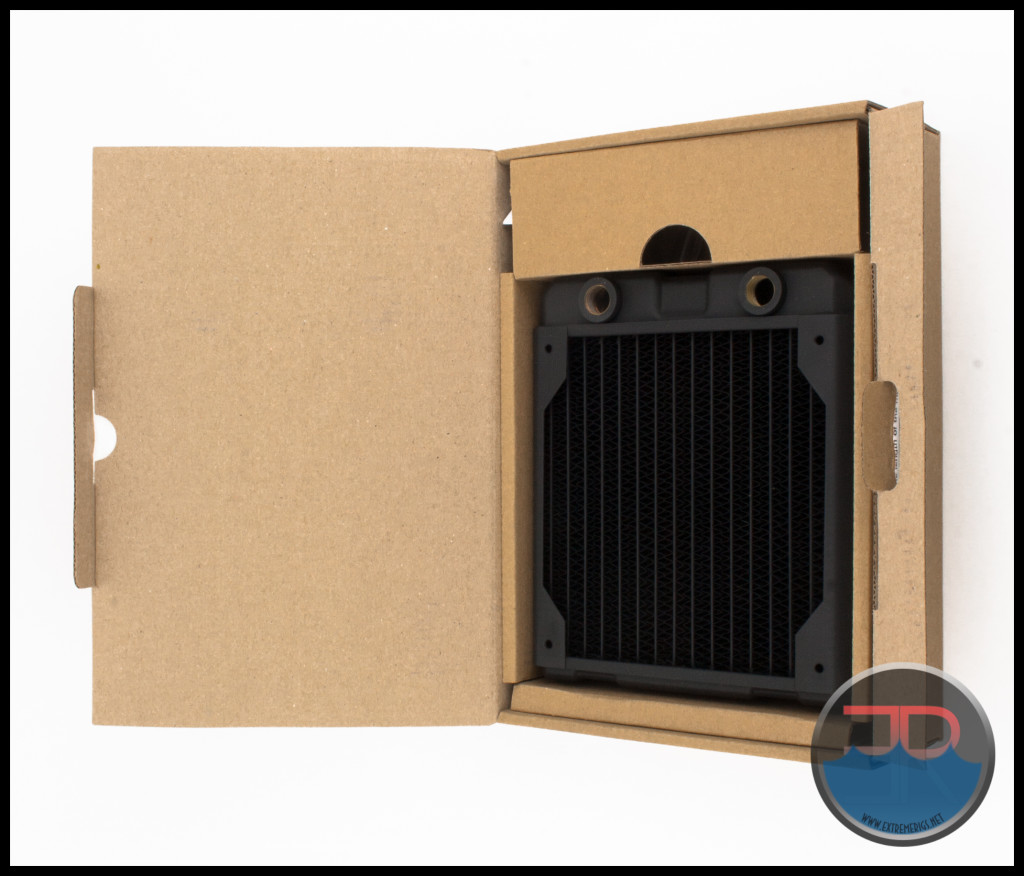
Under the flap on the right hand side, we found 2 bags with the supplied accessories along with mounting instructions specific to the GTX series radiators.
Extent of delivery:
1 x Nemesis 140GTX Radiator
4 x M4 x 28mm screws.
4 x M4 x 5mm screws.
1 x Nemesis GTX Installation instructions.
In previous reviews of GTX series radiators we coined a term “Opti-Flow” for obtaining maximum performance of the dual pass core by using the correct ports depending on air-flow direction. HWLabs now include a leaflet detailing how to “maximize” performance. We’ll detail more about this in the specifications.
There are four short and four long screws. These enable mounting a single fan to one side of the radiator using the 28mm screws. The 5mm short screws enable mounting of the radiator directly to the chassis. This means the radiator can be mounted either as an intake with the fan pulling, or exhaust with the fan pushing. In other words the supplied 28mm screws are not long enough to mount a fan between the case and radiator.
If you intend to run a fan between the case and radiator you will almost certainly need to provide your own M4 screws of suitable length. M4 x 30mm (course thread) should do the trick in most situations if you are using 25mm thick fans.
Onwards to technical specifications!
Technical Specifications
Technical specifications: as listed by Hardware Labs.
- 140 mm x 1 fan Xtreme form factor two-pass radiator
- 172mm x 153mm x 54mm (L x W x H)
- 16 FPI 25 Micron Copper Fins
- Now optimized for sub-800 rpm ultra-stealth fans
- Supercruise optimizations for scalable performance with higher speed fans
- 15% more tubing area in the same Black Ice® GTX™ 140 form factor
- Increased internal coolant flow rates
- Standard G 1/4″ inlet/outlet fittings
- Standard M4 mounting threads
- Custom Dark Matter™ high quality finish
- Fully ROHS Compliant
- 100% Made from conflict-free materials
- Industry standard Black Ice® quality
- Lifetime warranty against manufacturing defects*
Thanks to HWLabs we have a technical drawing of the Nemesis 140 GTX.
Dimensions Measured on the Radiator Tested:
 The + 1.5 on the thickness is the amount that the ports sit proud of the casing. Measured at the ports, the Nemesis 140 GTX is 55.5mm thick, which the tech drawing correctly indicates.
The + 1.5 on the thickness is the amount that the ports sit proud of the casing. Measured at the ports, the Nemesis 140 GTX is 55.5mm thick, which the tech drawing correctly indicates.
Radiator Core Dimensions:
 The Nemesis 140 GTX is a dual pass radiator, but not in the tradition sense where the coolant flow path is side to side such as in the following image.
The Nemesis 140 GTX is a dual pass radiator, but not in the tradition sense where the coolant flow path is side to side such as in the following image.
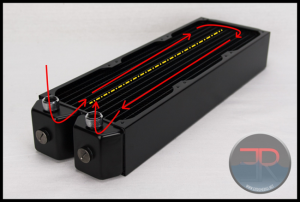 Instead the Nemesis GTX series is made up of 2 separate cores back to back and has a flow path of front to back OR back to front depending on which port is used as the inlet.
Instead the Nemesis GTX series is made up of 2 separate cores back to back and has a flow path of front to back OR back to front depending on which port is used as the inlet.
The flow path depicted in the following picture (Nemesis 360 GTX) has the red tube as warm coolant in and is optimized for air flow direction through the rad from the non port side, typically an intake installation. For a typical set-up with fans run as exhaust, the coolant flow path needs reversing to achieve maximum performance and is simply achieved by switching the inlet/outlet ports.
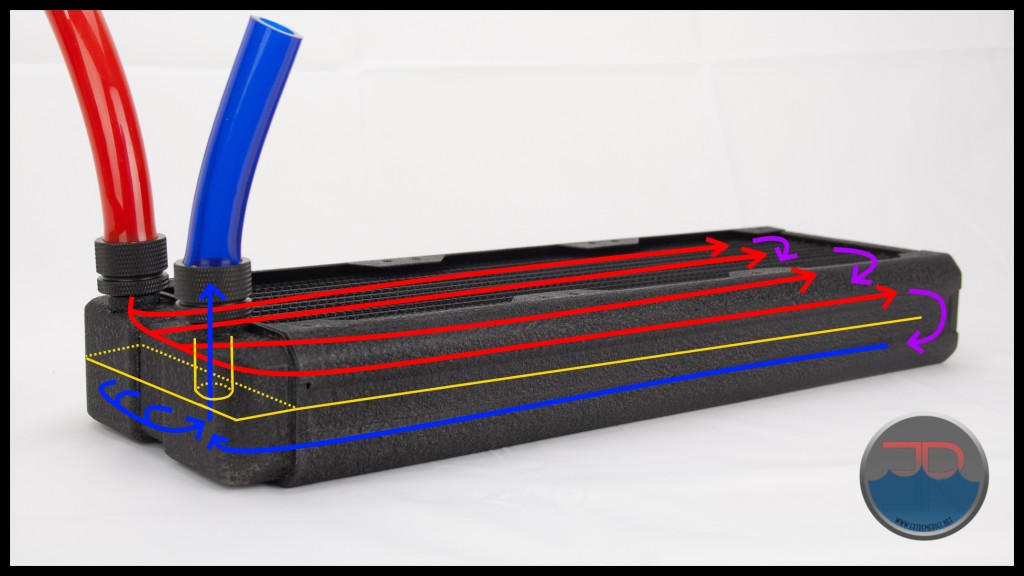
In other words the coolant travels up the tubes the full width of the radiator then changes direction in the non-port tank and travels down the other set of tubes on the opposite side. To get this flow path to work HWLabs have installed a plate and tube in the port tank end.
Each pass is a single row of 16 tubes which we measure at 1.35mm and has split, non louvered fins. HWLabs list the Nemesis 140 GTX to have 16 FPI, however on our sample we get a spread of 12 FPI to 14 FPI.
The split non louvered fins are quite evenly spaced on the medium density core.
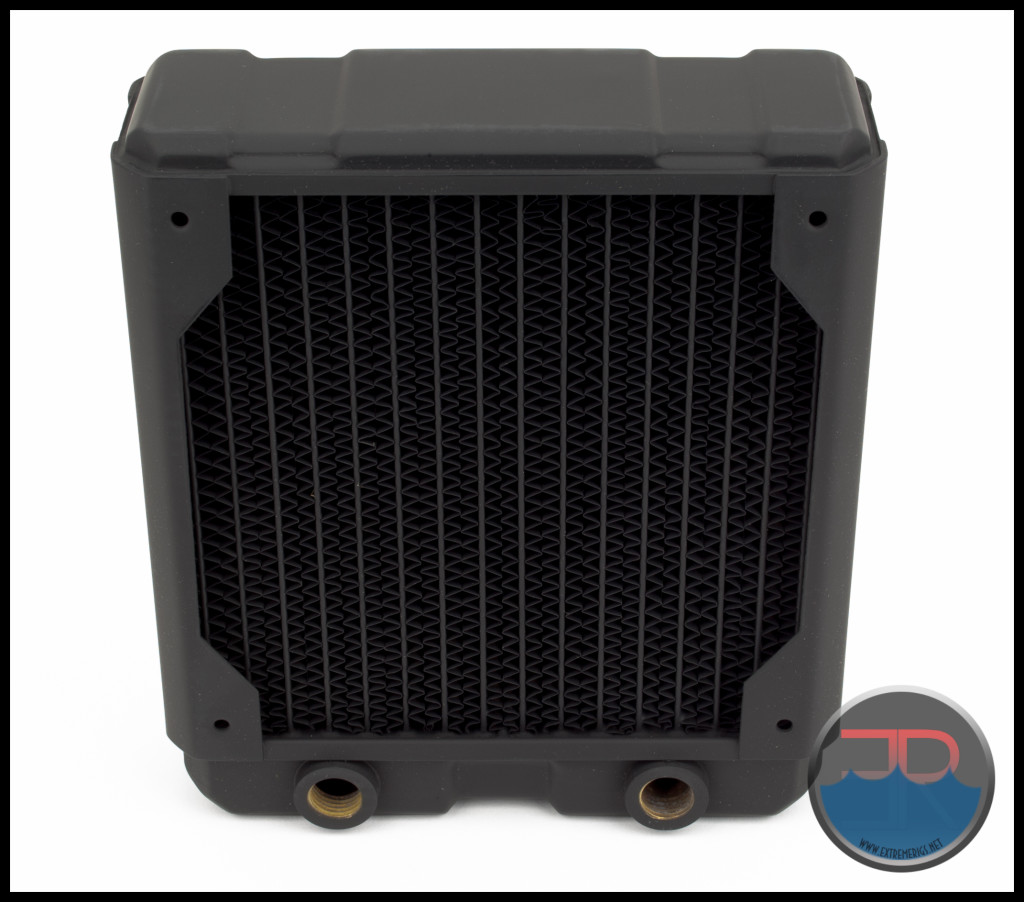 Please Note: alternate lighting was needed to get a decent picture of the fins. This distorts the color of the finish and it is not a true representation of the “almost” black shade of the “Black Carbon” paint finish.
Please Note: alternate lighting was needed to get a decent picture of the fins. This distorts the color of the finish and it is not a true representation of the “almost” black shade of the “Black Carbon” paint finish.
Finish and Features
HWLabs calls the finish “Black Carbon”, which is an accurate description. The finish on our sample of the Nemesis 140 GTX could almost be described Matte Black. However it is more like an extremely deep charcoal grey. It has a subtle yet stylish look which should work in great with almost any build’s theme.
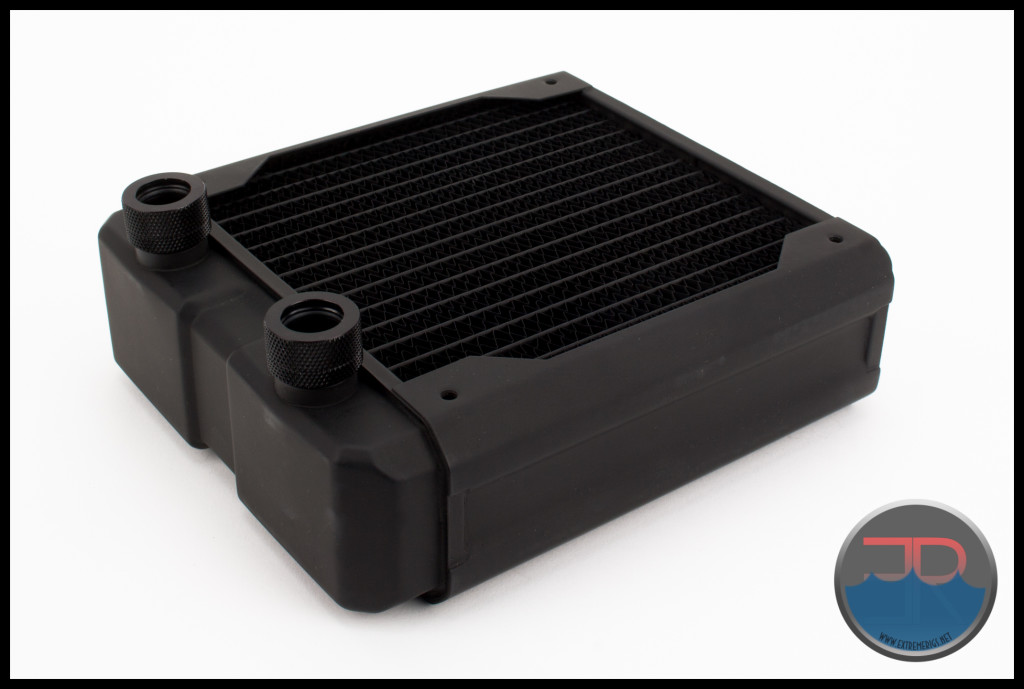
The Black Carbon finish of our sample we believe is for the European market. In the US, HWLabs’ offers the textured “Dark Matter” finish.
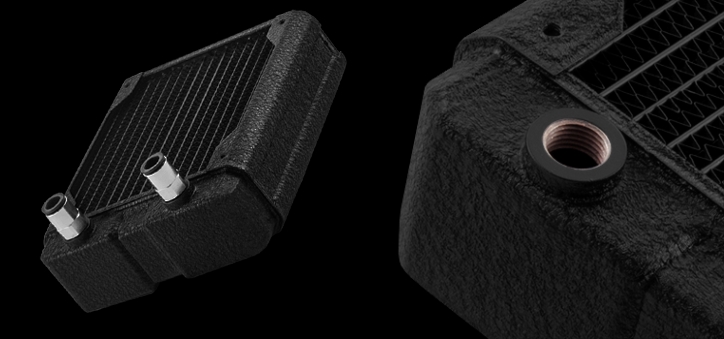 PerformancePCs also have a “primer only” version available of the Nemesis 140 GTX. To assist in the perfect paint job they sell the “HWLabs Professional Radiator Paint Hanger Assembly”.
PerformancePCs also have a “primer only” version available of the Nemesis 140 GTX. To assist in the perfect paint job they sell the “HWLabs Professional Radiator Paint Hanger Assembly”.
Additionally, PPCs also have listed red and white versions of the Nemesis 140 GTX. We assume these are the primer units which have had finishing coats applied by the PPCs team.
The Nemesis 140 GTX comes equipped with just the 2 x G1/4 ports.
While either port can be used for inlet or outlet, a performance advantage is obtained when the ports are matched to the airflow direction – “Opti-Flow” or “Maximize” which we detailed earlier.
No alternate ports are fitted:
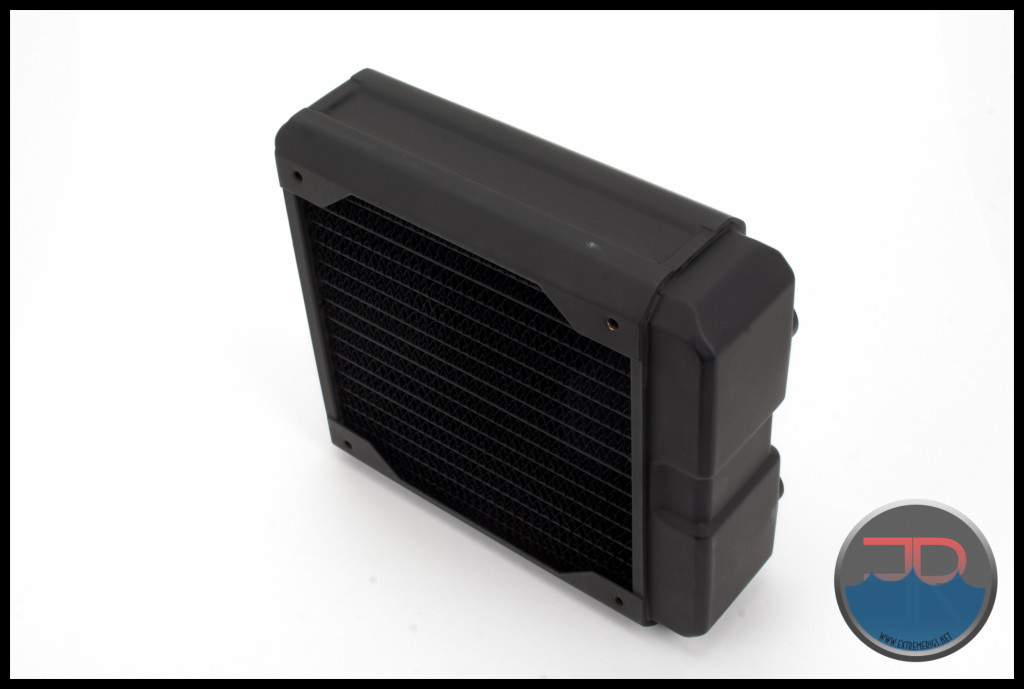
Given the nature of the port end’s internal design, the luxury of extra ports on the Nemesis GTX series is not something on the feature list. Not that it couldn’t be done. Extra ports could be fitted if another tube was fitted within the port end tank. This is unlikely to ever happen, so we hope the trade off is the gain in performance.
On the return end tank there is no auxiliary port fitted. This is unfortunately something which is missing on all HWLabs radiators.
The auxiliary ports often come in handy as a drain or fill port option on vertical radiator installations. This is on our wish list for future revisions of the GTX series.
Care has been taken during painting to ensure paint did not get into either of the G ¼ ports.
Unlike all other HWLabs radiators, there are no screw protection plates fitted on the Nemesis 140 GTX.
It seems unusual that HWLabs chose not to fit the plates, but as the fan screw holes are not located directly over any tubes the lack of plates is not overly important.
The Nemesis 140 GTX looks great when paired up with some black fittings:
Add your favored 140mm fan and you have a cooler that is ready for business:
So here we have a ~55mm thick 140mm radiator with a medium fin count which has no alternate port options. The build quality is excellent, and a variety of finishes are available.
Let’s see how it performs…
Flow Rate Testing
The Data
All the testing was performed with the exact same equipment as the 360mm radiator roundup. The only exception is the use of the 140mm Noctua Industrial fans replace the 120mm GT fans. We used the exact same methods as in the 360mm round-up. To see exactly how the tests were carried out, details of the test set ups and equipment used, please head over to the RRU Test Setup page.
Restriction Test
It’s generally agreed that radiators are some of the least restrictive components in the water cooling loop. There are some exceptions, so this must still be verified through testing:
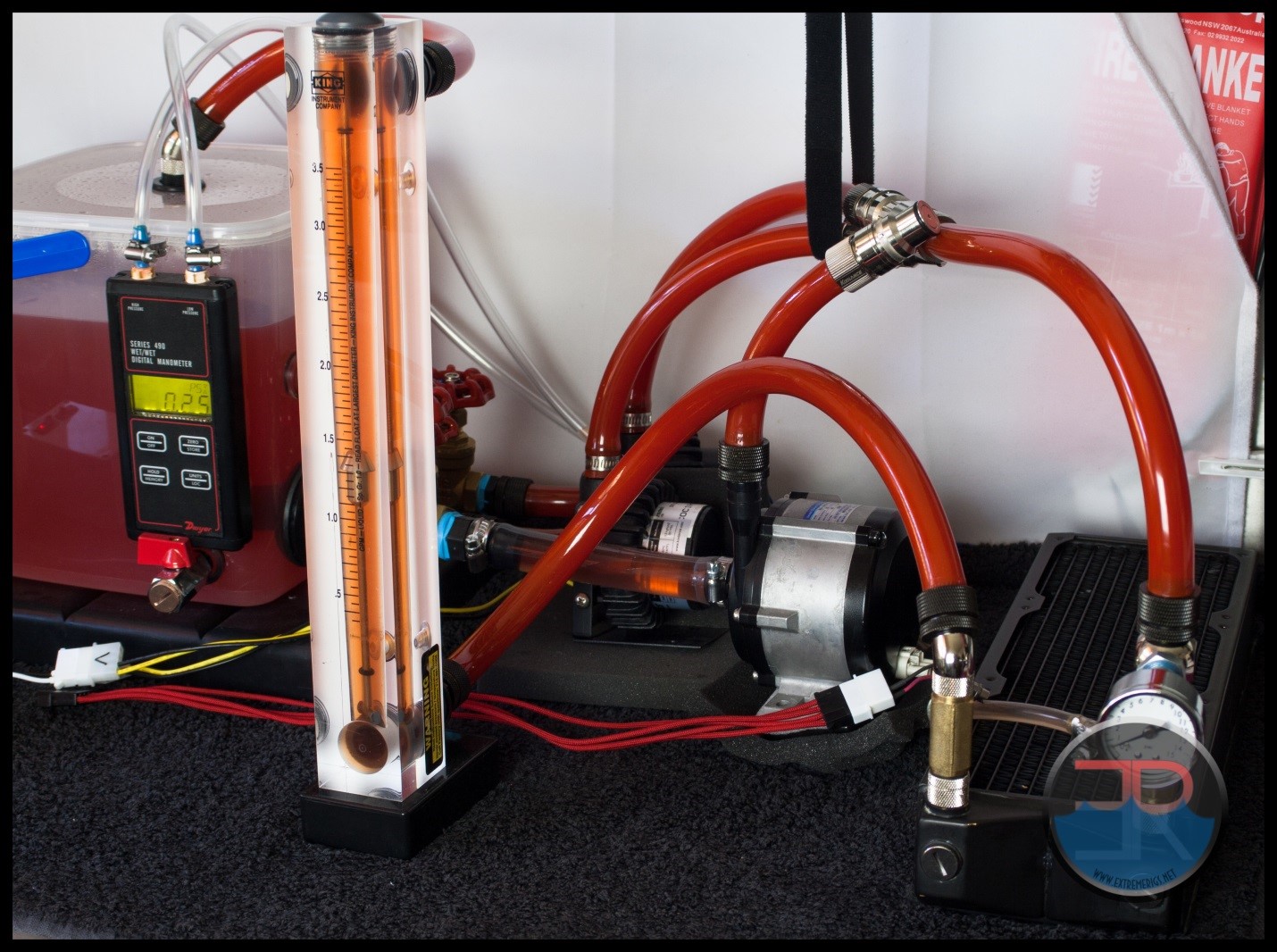 The above photo of the restriction test bench is for reference. The Nemesis 140 GTX is not loaded so please disregard any data from the picture.
The above photo of the restriction test bench is for reference. The Nemesis 140 GTX is not loaded so please disregard any data from the picture.
Here is the raw data at the tested flow rates. Flow rate was increased and the differential pressure was measured:
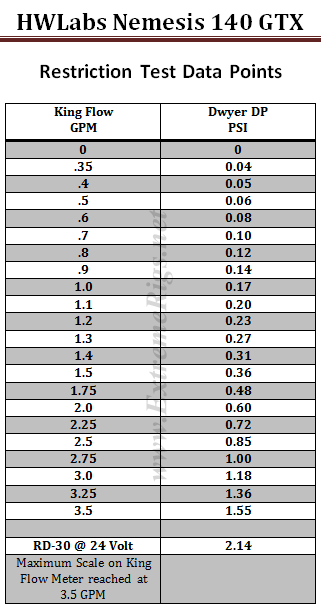 The table numbers show that this Nemesis 140 GTX is quite a low restriction radiator. However numbers in isolation can only tell half the story. By plotting against other components it more easily shows the whole story.
The table numbers show that this Nemesis 140 GTX is quite a low restriction radiator. However numbers in isolation can only tell half the story. By plotting against other components it more easily shows the whole story.
We have decided to use a HeatKiller 3.0 CPU block as the reference in this next plot for two reasons. Firstly there is no chance of the plot being cluttered by curves overlapping. Secondly it gives a reference point against a common loop component of average restriction.
We have limited the maximum flow rate displayed to 2.0 GPM as we suspect there are few systems that operate above 2.0 GPM. For more information on how to read a restriction plot check out our guide.
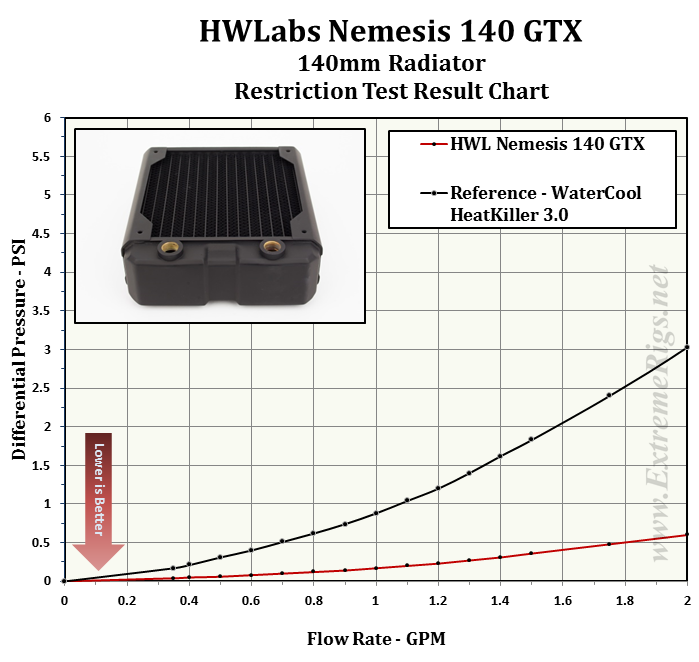 This plot indicates the Nemesis 140 GTX is a very low restriction loop component. What about compared to other radiators?
This plot indicates the Nemesis 140 GTX is a very low restriction loop component. What about compared to other radiators?
The next three plots show the restriction level at three different flow rates compared to the other 140mm radiators tested. We consider the chosen GPM rates to represent systems which have low, medium and high flow rates.
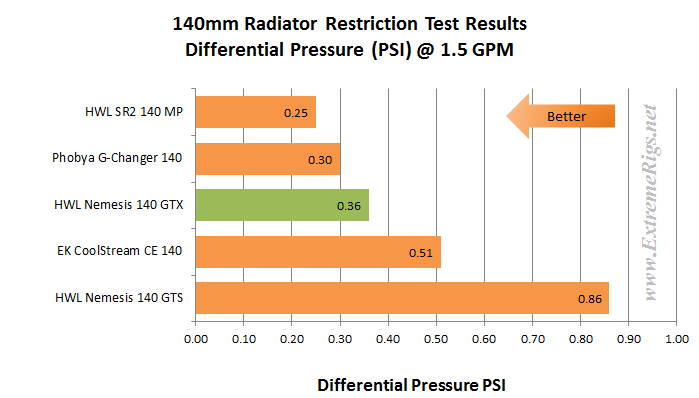 These 3 plots indicate that the Nemesis 140 GTX is a low to medium restriction radiator when compared to some other 140mm models.
These 3 plots indicate that the Nemesis 140 GTX is a low to medium restriction radiator when compared to some other 140mm models.
Lets now take a look at where the Nemesis 140 GTX fits in relation to all the radiators we have tested. For this plot, only results for 1.0 GPM have been used for the comparison.
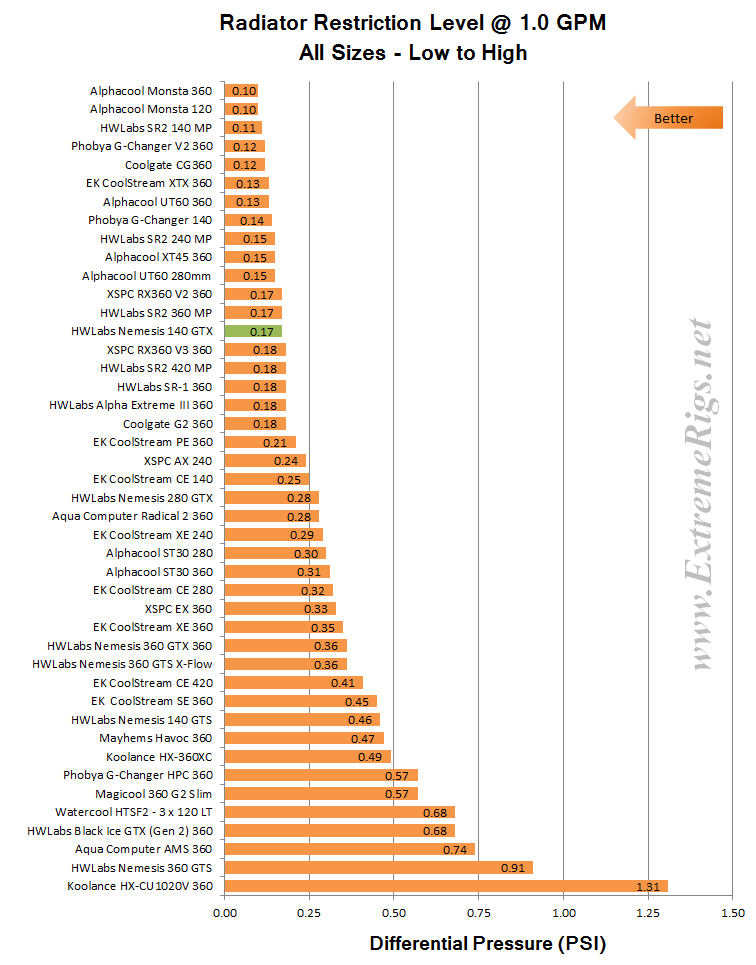 When put into context with all the radiators, we rate the Nemesis 140 GTX as a radiator with a low restriction level.
When put into context with all the radiators, we rate the Nemesis 140 GTX as a radiator with a low restriction level.
Before we move on, let’s isolate the current HWLabs radiators from the rest and see how they line up at 1.0 GPM. We have separated the SR2, Nemesis GTX and Nemesis GTS series by color coding and it show us nicely how each series restriction level scales as the size increases.
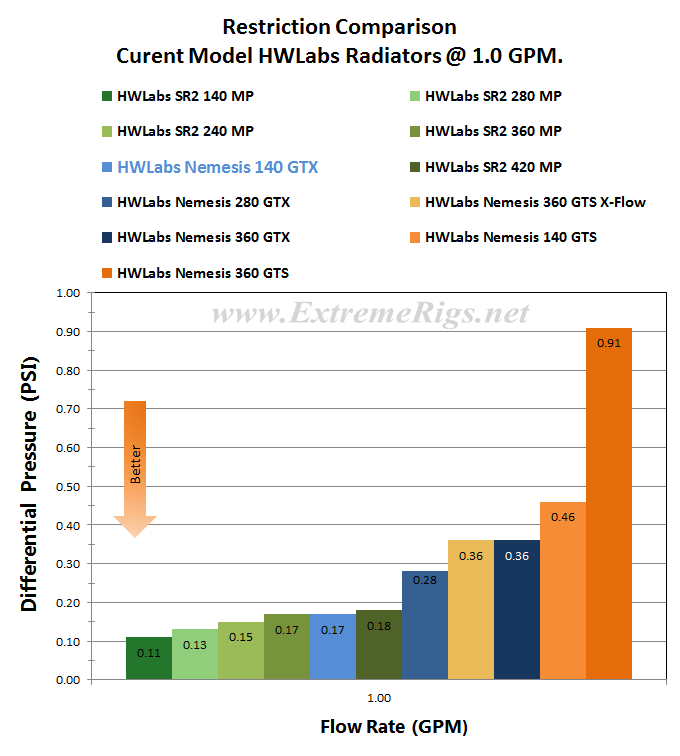 Essentially all the radiators scale up in restriction as they grow in length. However the SR2 models are always extremely low, while the GTX is in the middle and the GTS is quite high indeed.
Essentially all the radiators scale up in restriction as they grow in length. However the SR2 models are always extremely low, while the GTX is in the middle and the GTS is quite high indeed.
Onwards to Thermal Performance!
Thermal Testing
The Thermal Data
A total of 6 tests were conducted at 1.0 GPM with fan speeds of 750 rpm, 1300 rpm and 1850 rpm being run in ‘Push Only’ and ‘Push/Pull’. All inclusive this testing takes between 40 – 50 hours of logging time (plus processing the data) to get the results that are presented.
Below is the final data results gathered from at least 5 data logging runs at the flow rate and fan rpm combination. The most stable 15 minute period from each logging run was used and then averaged with the other runs to obtain the data for the table below. A total of 16 temperature sensors were used in the thermal test chamber (8 air in, 2 air out, 3 water in, 3 water out). Each sensor takes a reading every second and is logged via a CrystalFontz unit.
The data in the table below is the averaged results of the logging runs which has then been used to create all the plots and tables there-after.
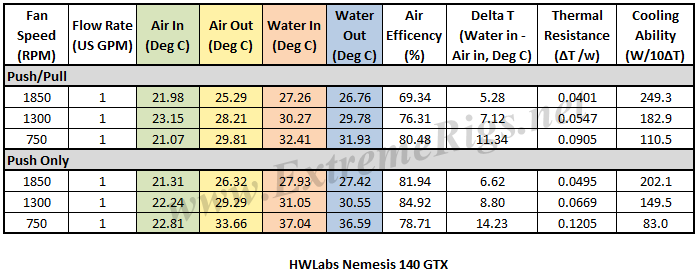 Note: All test were conducted with the coolant flow path set up to “Maximize” performance, or in Opti-Flow as we call it. For our Nemesis 360 GTX review we actually tested performance with coolant flow in both directions and for those interested the comparison results can be found here.
Note: All test were conducted with the coolant flow path set up to “Maximize” performance, or in Opti-Flow as we call it. For our Nemesis 360 GTX review we actually tested performance with coolant flow in both directions and for those interested the comparison results can be found here.
The performance metric of critical importance is the delta between the warm coolant temperature in and the cold ambient air temperature going into the radiator. Given that the system is well insulated and in equilibrium and we know the heat input to the system then we can also calculate a very important number. That number is the amount of power required to raise the coolant temperature by set amount. That amount is typically 1C or 10C. The latter is a more useful reference point.
Let’s take a look at the Delta T results from the tests. Note that the extrapolation of the curve is much more sensitive to error than in the tested range.
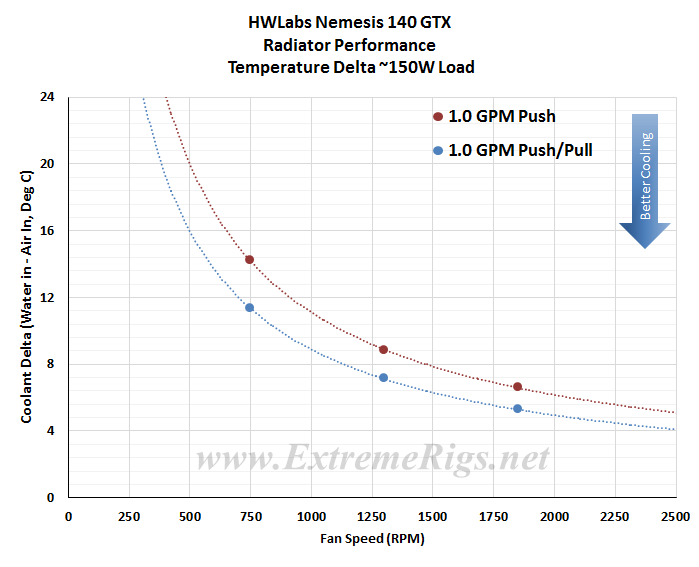 I was not too concerned about the actual delta numbers but instead the trend pattern. As we should expect, the deltas come down significantly as the fan speed is increased.
I was not too concerned about the actual delta numbers but instead the trend pattern. As we should expect, the deltas come down significantly as the fan speed is increased.
Delta T results (as above) are not always helpful when thinking about how many radiators you would need to cool your system. Instead it’s more useful to know the metric of W/delta C. This metric is plotted below. It tells us how many watts are dissipated by the radiator when the coolant rises 10C above ambient temperatures. (W/10 Delta T):
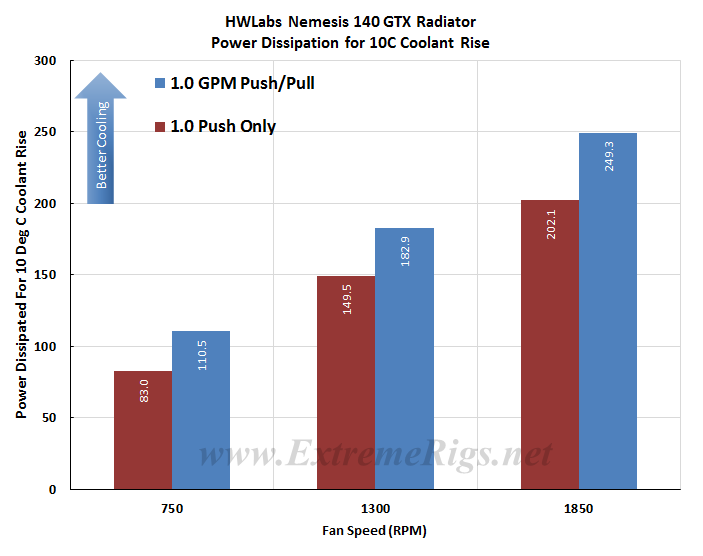 Here we can see good performance gains achieved by the medium density ~42mm thick core when the second fan is added.
Here we can see good performance gains achieved by the medium density ~42mm thick core when the second fan is added.
This same data can now be plotted on a chart so that an end user can interpolate their own fan speed. Note again that the extrapolation of the curve is much more sensitive to error than in the tested range.
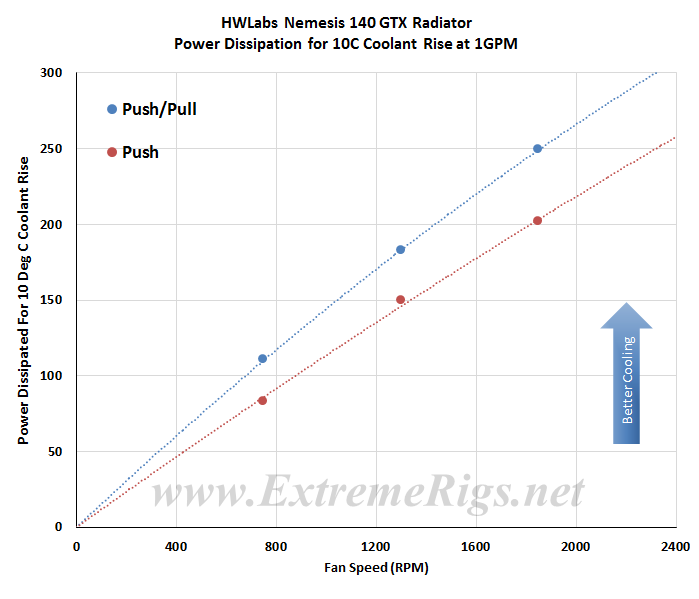 Having an average difference of 21% (largest of the test group) between Push Only and Push/Pull indicates that the Push/Pull results were very good indeed, or maybe that Push Only was very weak
Having an average difference of 21% (largest of the test group) between Push Only and Push/Pull indicates that the Push/Pull results were very good indeed, or maybe that Push Only was very weak
Let’s find out as we analyze that data some more…
Data Analysis
This first table shows the HWLabs Nemesis 140 GTX’s Watts/10 Delta Temp results with our flow rate of 1.0 GPM.
 Using this data we can effectively show percentage gains/losses relative to a reference point. It’s an interesting way to show gains/losses while changing a variable.
Using this data we can effectively show percentage gains/losses relative to a reference point. It’s an interesting way to show gains/losses while changing a variable.
So, let’s focus on 1300 RPM as our reference and see how much gain or loss in performance we get by changing fan speed.

The significant drop form 1300 rpm to 750 rpm in Push Only hints a possible performance weak point of the Nemesis 140 GTX. We saw similar performance drop off in Push Only of 45.5% on the Nemesis 360 GTX
So from the data above we have a good idea of how the Nemesis 140 GTX radiator performs relative to itself. But there is a large selection of 140mm radiator models to choose from.
We have some other 140mm radiators with thermal testing completed. So let’s put the Nemesis 140 GTX’s results into some comparison charts.
Push Only Data vs Competition
Let’s focus on the Push Only results for now and come back to the Push/Pull data later.
Starting with 750 RPM let’s see how the Nemesis 140 GTX performs comparatively.
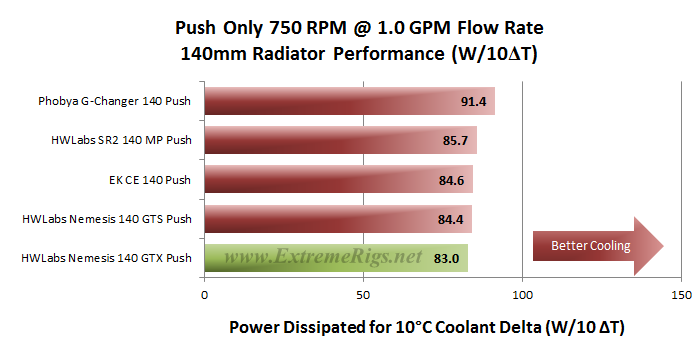
Results are always close at this data point, but here we see a clear winner. As our performance table indicated this is a weak result for the Nemesis 140 GTX. Of special interest is the Nemesis 140 GTS out performing it’s thicker sibling. Finishing ~9% behind the wining rad we hope things improve from here.
When testing the Nemesis 360 GTX we found that with low fan speeds in Push Only, a reversed coolant flow path produced better thermal results than Opti-Flow. This is surprising and not expected, but was consistent with every Nemesis we tested and re-tested. While we don’t have data to prove it, we see no reason why it would be any different for the Nemesis 140 GTX.
Now let’s look at 1300 rpm:
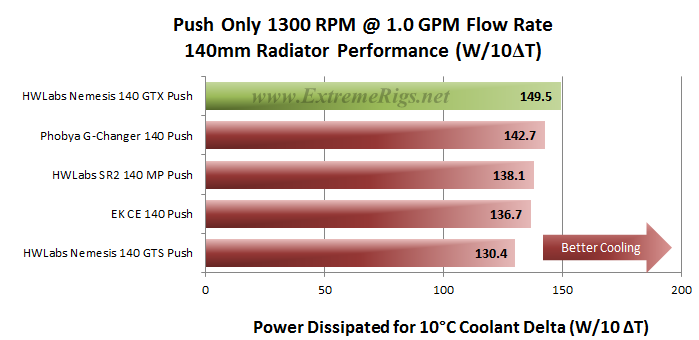
At 1300 rpm Push Only the Nemesis 140 GTX shoots out to take 1st place. There is something about the Nemesis GTX rads where they perform poorly at low rpm at Push Only.
At 1850 rpm the Nemesis 140 GTX again takes 1st place and is pulling further ahead of the competition.
The Push Only comparison results for the Nemesis 140 GTX are mixed, ranging from worst with low fan speed to best in both the medium and high speed fan tests. When adding the second fan for Push/Pull we expect the dominance with higher air flow to continue.
Push/Pull Data vs. Competition
Let’s now look at the Push/Pull results and see how the Nemesis 140 GTX compares.
Again the 750 rpm first:
The Nemesis 140 GTX 140 turns out another first place performance, ~3.5% ahead of second place.
Let’s move to 1300 rpm:
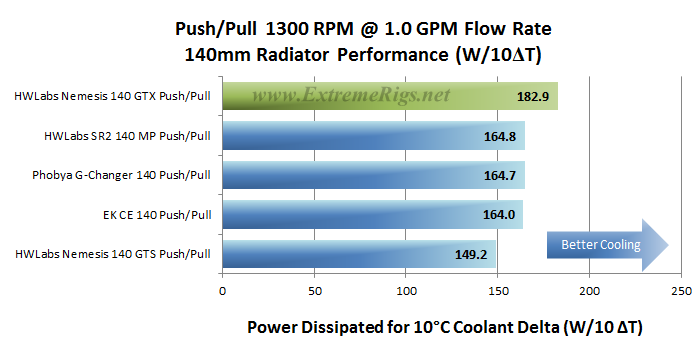 The 1300 rpm Push/Pull result for the Nemesis 140 GTX was excellent! Taking another win, this time ~11% ahead of the competition.
The 1300 rpm Push/Pull result for the Nemesis 140 GTX was excellent! Taking another win, this time ~11% ahead of the competition.
Now 1850RPM:
At 1850 rpm Push/Pull the Nemesis 140 GTX again finishes first.
Let’s now combine the Push Only and Push/Pull results of our 1.0 GPM flow rate tests. Sometimes these combined plots show up some points of interest.
Again the 750 rpm first:
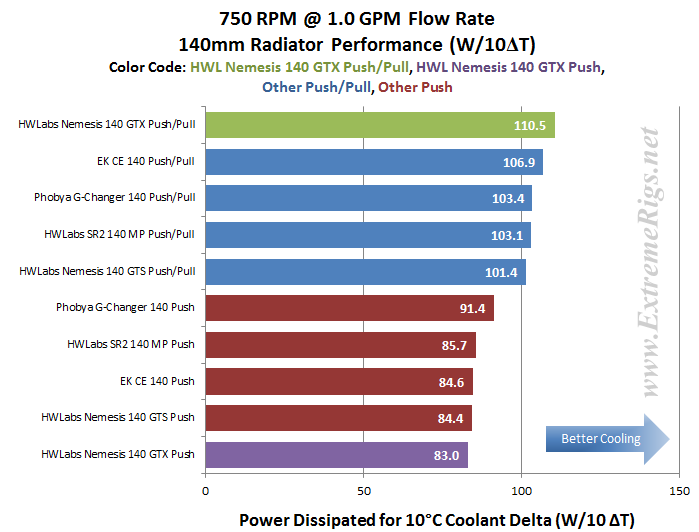 I am pretty sure we haven’t seen this before, the same radiator finishing first and last on the same plot.
I am pretty sure we haven’t seen this before, the same radiator finishing first and last on the same plot.
However, at 1300 rpm the Nemesis 140 GTX’s Push Only result improves dramatically to beat out the GTS in Push/Pull.
At 1850, there are no surprises given what we have already reviewed.
Quite an outstanding set of comparison results for the Nemesis 140 GTX, taking 5 wins out of the 6 data points at which we conducted the thermal testing.
Here is one last alternate view of the data before we move onto the summary. This time the data is plotted as extrapolated curves.
Push Only first up: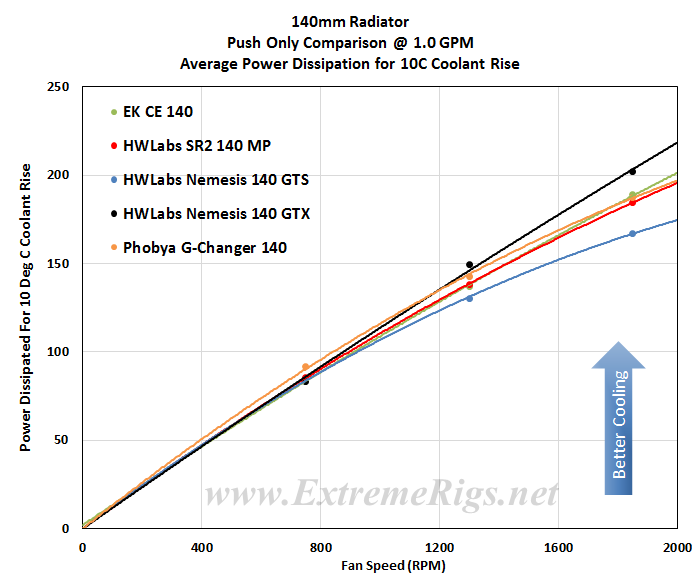 This plot perhaps best shows just how close the Push Only results are at the low fan speeds while at the high fan speed we clearly see the performance advantage the Nemesis 140 GTX has over the competition.
This plot perhaps best shows just how close the Push Only results are at the low fan speeds while at the high fan speed we clearly see the performance advantage the Nemesis 140 GTX has over the competition.
In the Push/Pull setup we see a bit more separation occurring. As the fan speeds are increased the different core designs show their strengths and weaknesses.
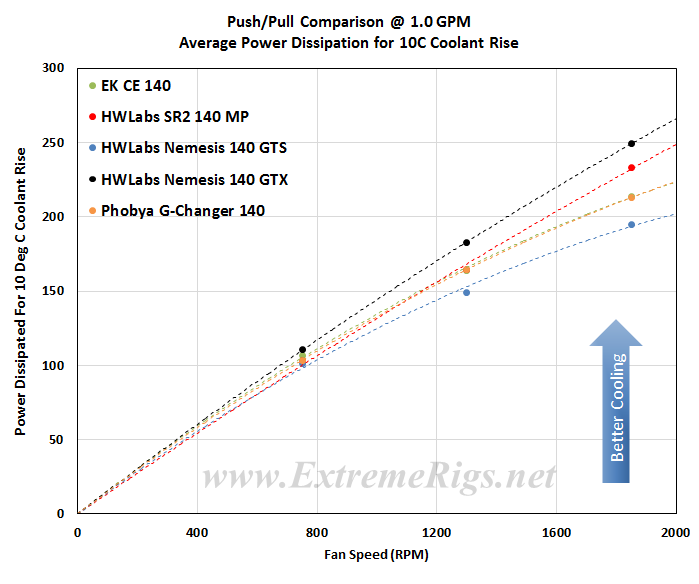 At 1850 RPM Push/Pull the Nemesis 140 GTX wins at all three fan speeds. It’s comparison performance continues to improve as the fan speed is increased.
At 1850 RPM Push/Pull the Nemesis 140 GTX wins at all three fan speeds. It’s comparison performance continues to improve as the fan speed is increased.
From all the test results we created “Average Performance Factor” charts for both Push and Push/Pull. We then made a combined plot of the average called the “Master Performance Factor”. The radiator with the best cooling ability (W/10ΔT) at each rpm was awarded a score of 100. Each other radiators W/10ΔT result was scored as percentage of the top performer.
This way of looking at the comparison takes away any advantages that a radiator may have at higher or lower fan speeds and looks at an overall average. While this appears fair it does tend to favor those radiators that are all-rounders and those radiators which do very well at high RPM. Most users should be more focused on their specific use case.
Here are the Nemesis 140 GTX’s percentage scores at each data point:
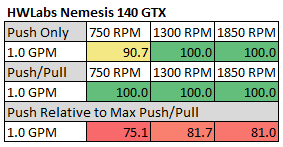 Clearly we see the Nemesis 140 GTX was dominant in 5 of the 6 data points tested. Additionally it also highlights the weak performance point it has. This should make for some excellent APF scores but will it’s one low results prevent it from taking the trifecta of APF wins?
Clearly we see the Nemesis 140 GTX was dominant in 5 of the 6 data points tested. Additionally it also highlights the weak performance point it has. This should make for some excellent APF scores but will it’s one low results prevent it from taking the trifecta of APF wins?
The percentage numbers in the table above offer another way of looking at the Nemesis 140 GTX’s results. But for our scoring system we need a way to reduce the categories while retaining the data. To do this we average the results for each fan assembly type giving us Averaged Performance Factors. We calculate this for Push Only, Push/Pull and finally an average of everything.
Firstly – the Push Only APF:
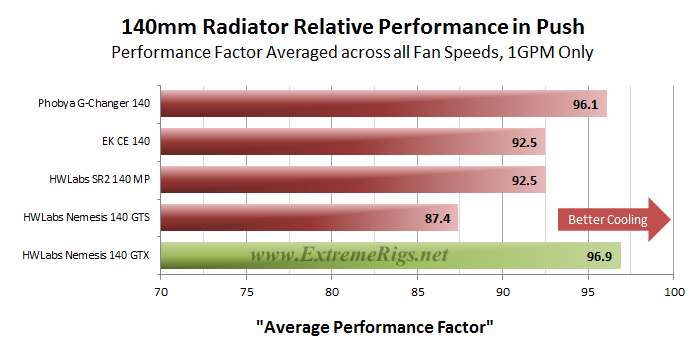
The Nemesis 140 GTX’s excellent Push Only APF score of 96.9 was good enough to take 1st place.
Now the Push/Pull APF:
Having placed 1st in each of the 3 Push/Pull tests, the Nemesis 140 GTX was the clearly the dominant radiator in this category.
Finally we created the Master Performance Factor which is calculated from the averaged results of all the tests: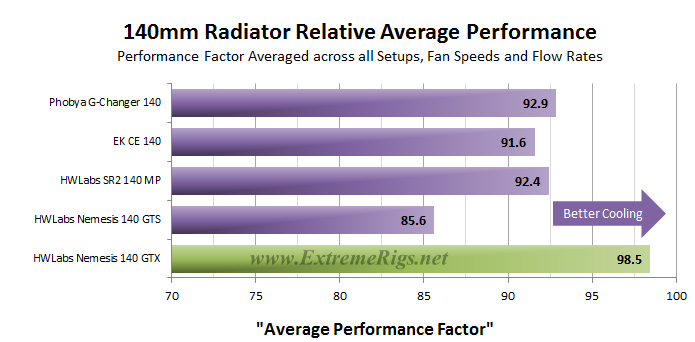 Overall the Nemesis 140 GTX placed 1st in our thermal test comparisons. With 5 out of 6 category wins, it’s performance was indeed truly excellent in all but the low speed Push Only test.
Overall the Nemesis 140 GTX placed 1st in our thermal test comparisons. With 5 out of 6 category wins, it’s performance was indeed truly excellent in all but the low speed Push Only test.
Next up – Summary!
Summary
Thermal Performance
Thermal Performance scores are derived from the relevant Performance Factor scores. We set this scale with 72.5% and below as the 0 mark, with each 2.5% increase in relative performance adding 0.5 to the awarded performance score.
Push Only Thermal Performance
- 4.5/5
The Nemesis 140 GTX’s Push Only APF result of 96.9% translated into a thermal performance score of 4.5/5. It’s dual pass core produced excellent results at medium and high fan speeds, but was not able to match performance of the competition with low fan speeds.
Push/Pull Thermal Performance
- 5/5
The Push/Pull Performance results were dominated by the Nemesis 140 GTX placing 1st in each fan speed tested. It’s amazing 100% APF result translated into a rarely seen, perfect performance score of 5/5.
Overall Thermal Performance
- 5/5
The Master Performance score of 98.5 generates another perfect performance score of 5/5. The fact that the overall score incorporates both Push Only and Push Pull results make the 5/5 score even more amazing because a radiator that performs well with one fan assembly usually has weaker performance in the other.
Features & Quality – 4/5
Like all HWLabs radiators, the Nemesis 140 GTX has excellent packaging, but is lacking bubble wrap protection that we wish they had. Screws are provided for installation and mounting of a single 25mm thick fan in certain scenarios. The screw lengths do restrict the installation options without the end user purchasing additional screws.
The build quality of the Nemesis 140 GTX is excellent as is the Black Carbon finish of the review sample. There are only two primary ports and there is no auxillary bleeder/fill port fitted. Tube protection plates are not fitted, however tubes are not directly under the mounting holes.
Our review sample had a medium fin count of 13 FPI, which is lower than the stated specs of 16 FPI. The Nemesis 140 GTX has a low restriction level and therefore pump power is not an issue even when running multiple Nemesis GTX series radiators in the same loop.
Summary – Gold Award 4.5/5
The Nemesis 140 GTX had excellent thermal comparison results in all but Push Only with low fan speeds. At all other fan combinations and speeds it was the dominant performing radiator of the test group. The difference in performance results at Push Only low fan speeds was in reality quite low, so we are prepared to call the Nemesis 140 GTX an excellent all round radiator.
The build quality is excellent, as was the Black Carbon finish on the review sample, although it will scuff up if care is not taken when handling it. There are just the one set of ports which the user needs to plumb up correctly to achieve maximum performance and there is no auxiliary port fitted.
At 55mm thick the Nemesis 140 GTX can be defined as a thick radiator, however most chassis with water cooling in mind can easily accommodate it with at least a single fan. If you intend to run Push/Pull check prior to purchase that you have the required clearance of 105mm (plus fittings)
Whether to give the Nemesis 140 GTX a Silver or Gold award was the tough choice. It is lacking any alternate ports and we feel is missing 30mm screws in the accessory set, but it’s thermal performance is hard to overlook. It was clearly the superior radiator at heat dissipation having the best performance in 5 of our 6 thermal tests, so for this reason we are awarding the Nemesis 140 GTX with our converted Gold Award.
Where to buy:
Performance PCs:
Nemesis 140GTX (Dark Matter) – $60 + Shipping from USA.
Nemesis 140GTX (Primer) – $60 + Shipping from USA.
Nemesis 140GTX (White) – $65 + Shipping from USA.
Nemesis 140GTX (Red) – $65 + Shipping from USA.
Watercooling UK
Nemesis 140GTX (Black Carbon) – £38.18 ex VAT + Shipping from UK







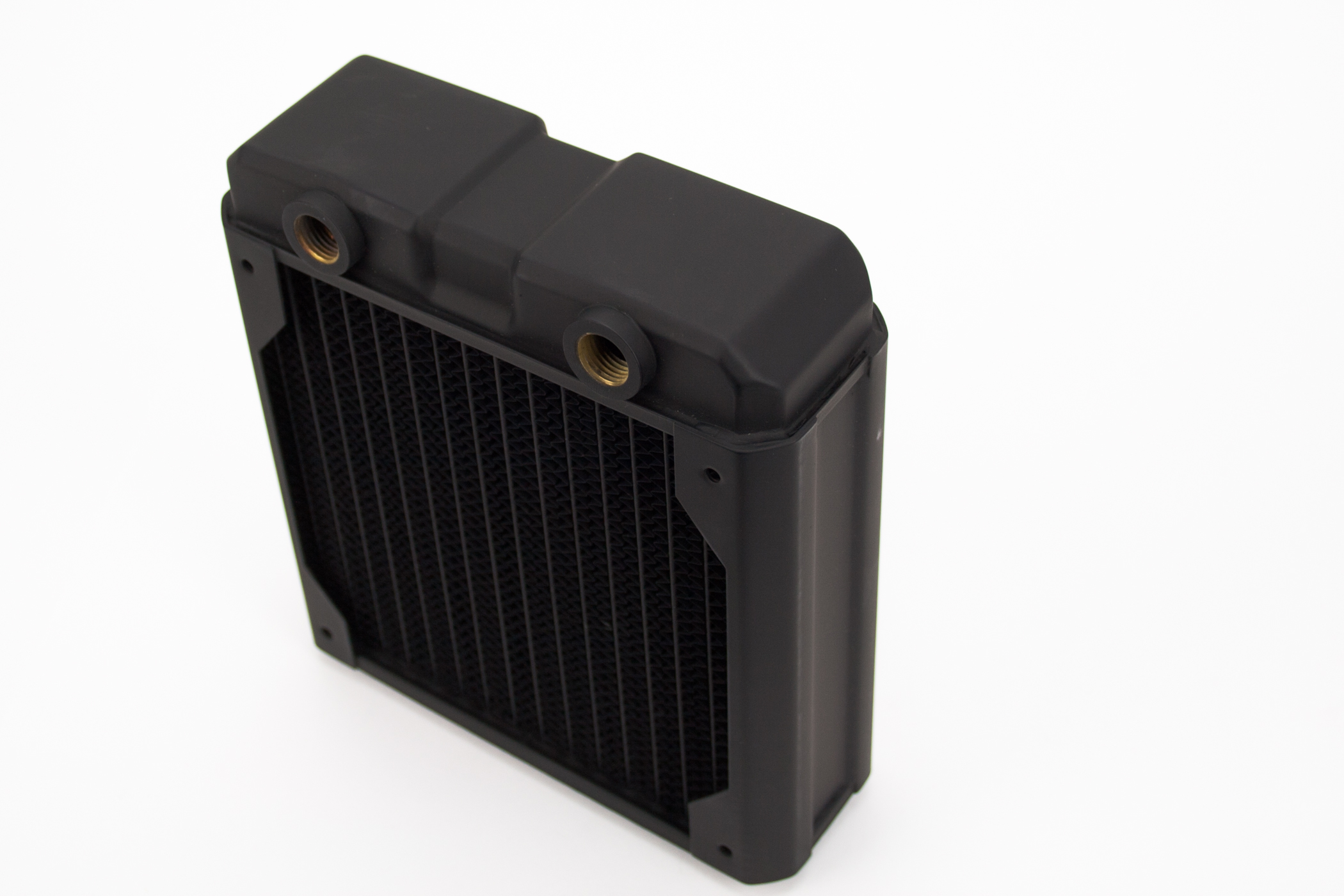

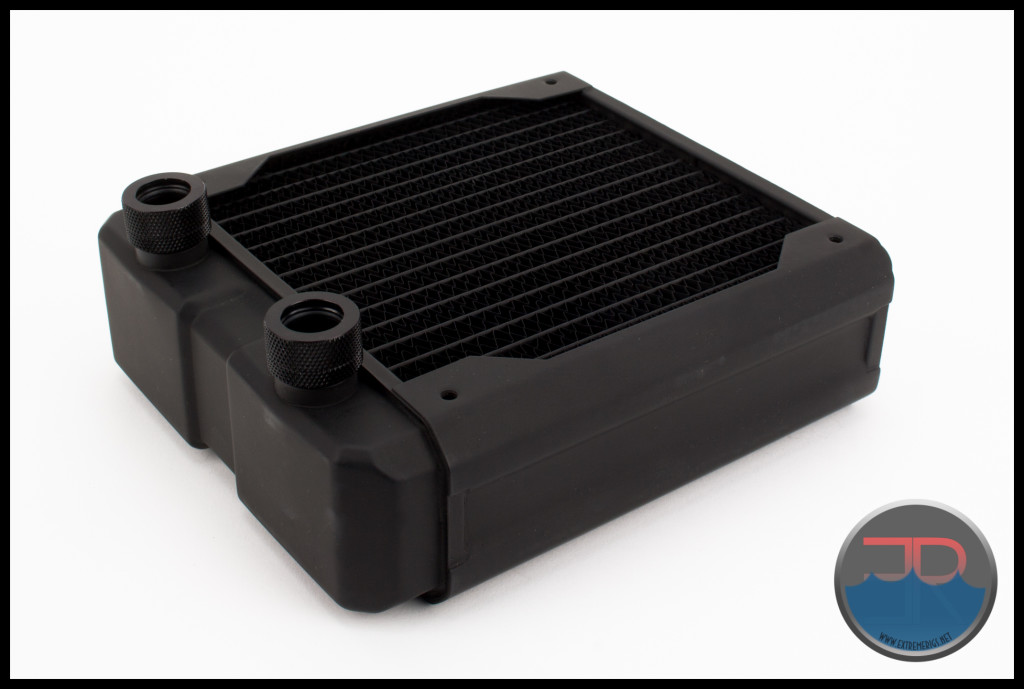

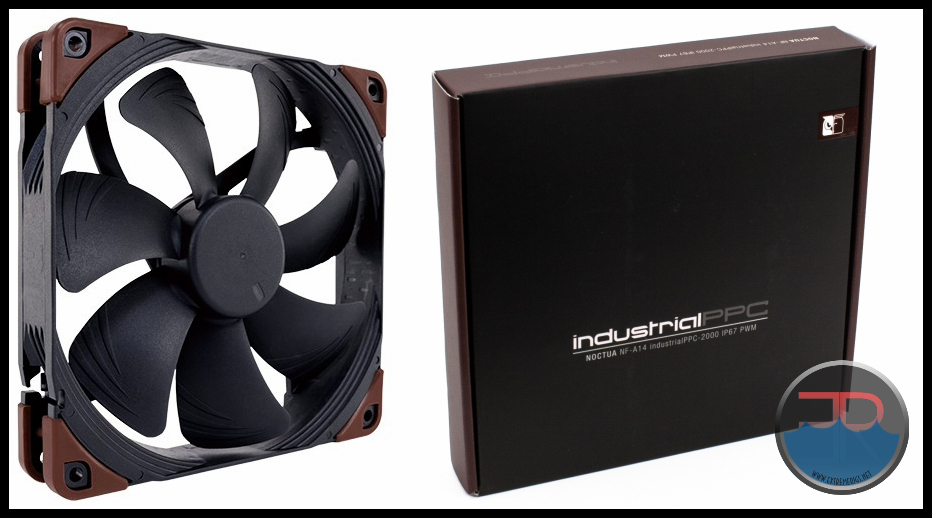
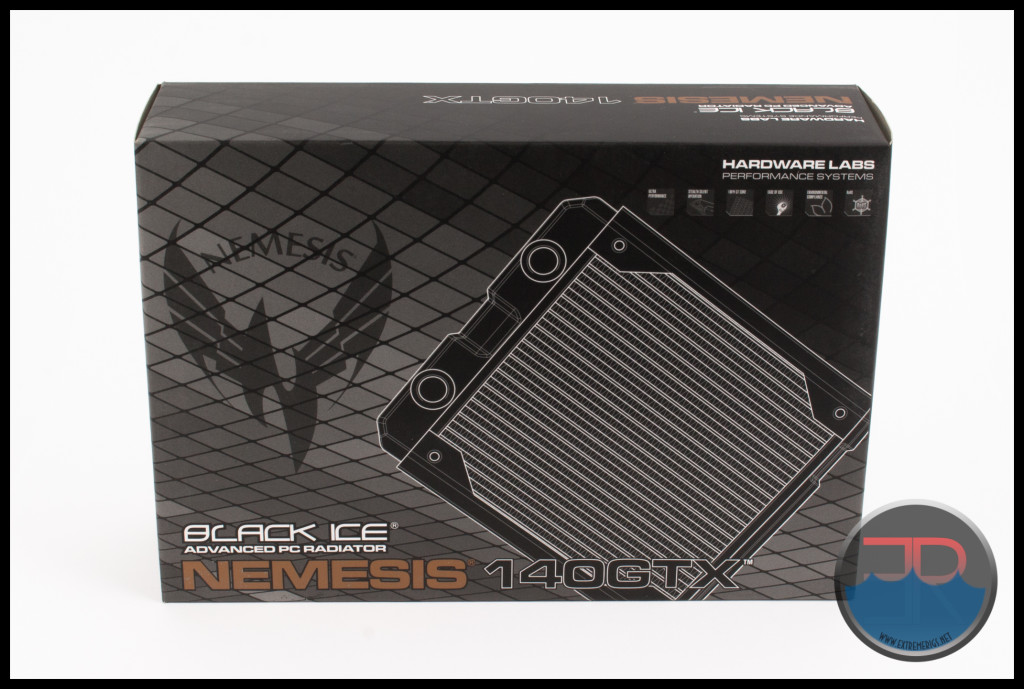
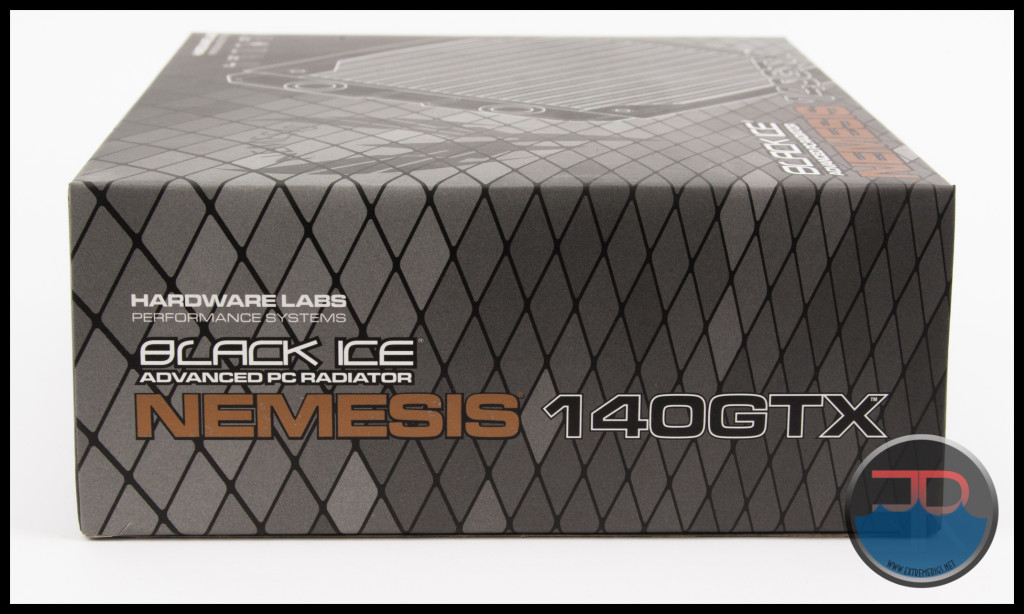
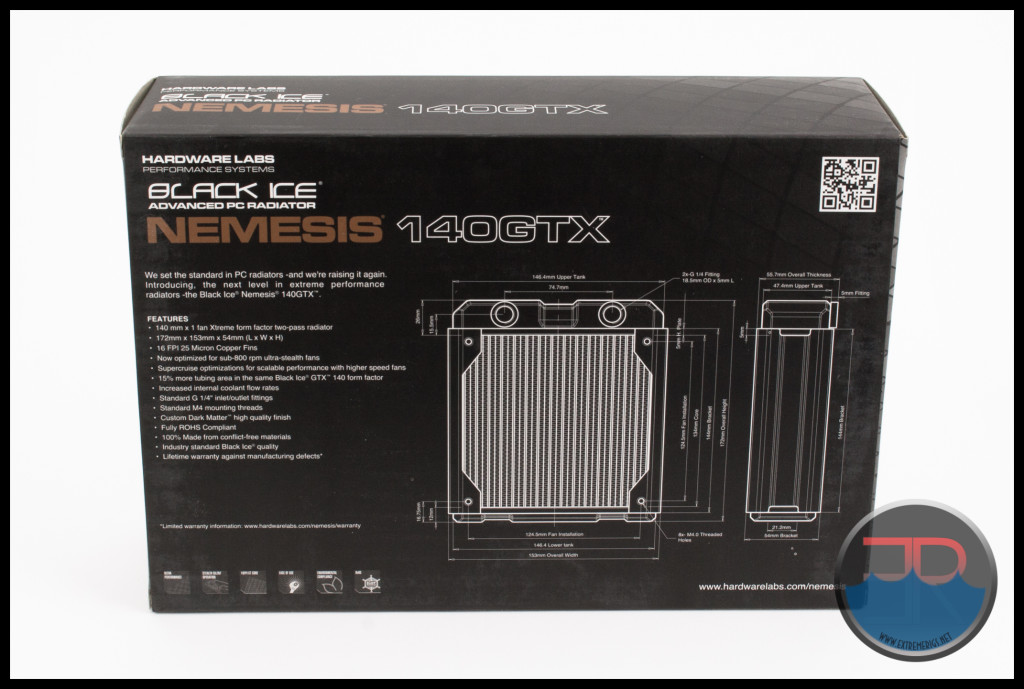
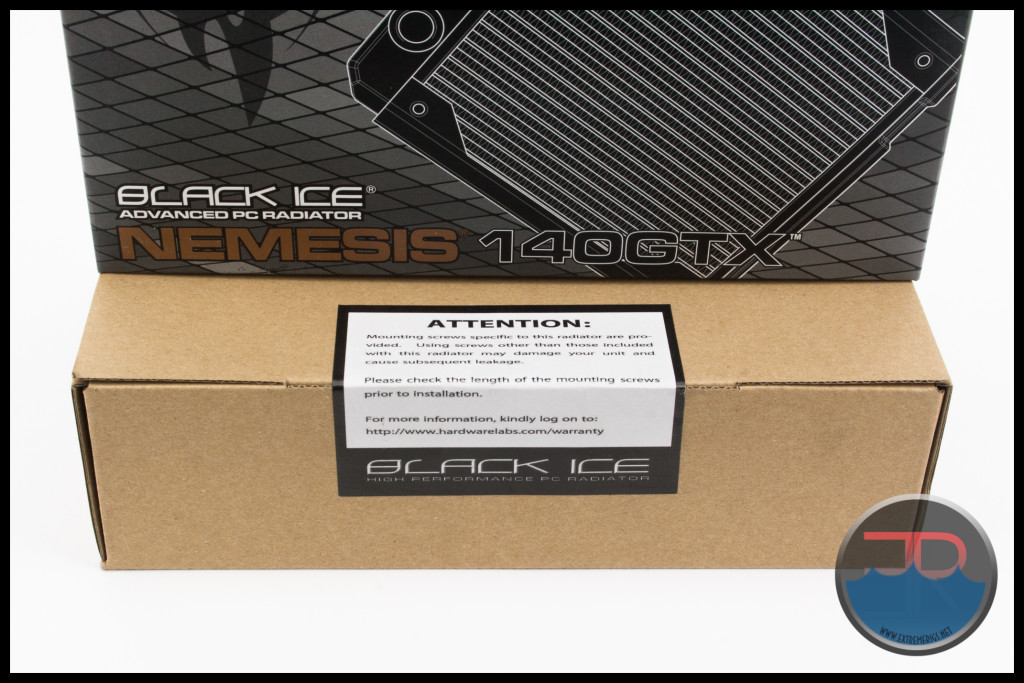
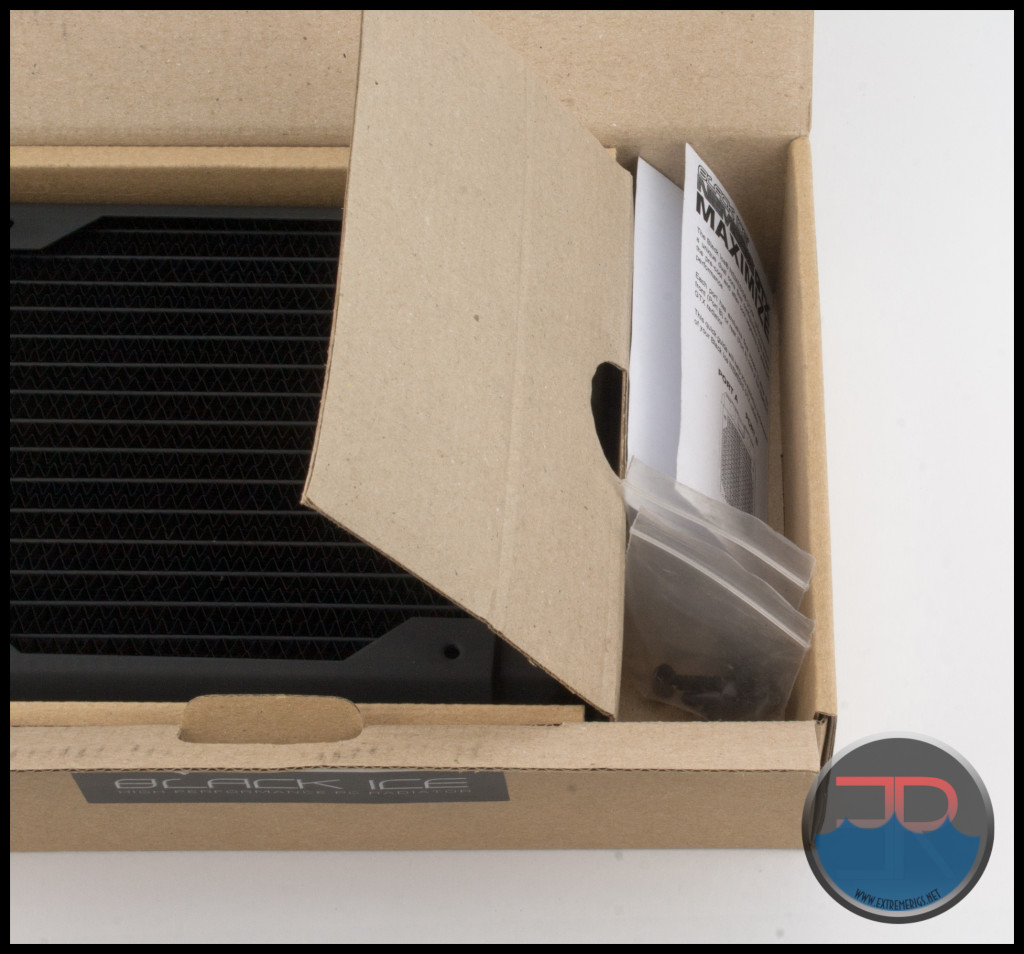
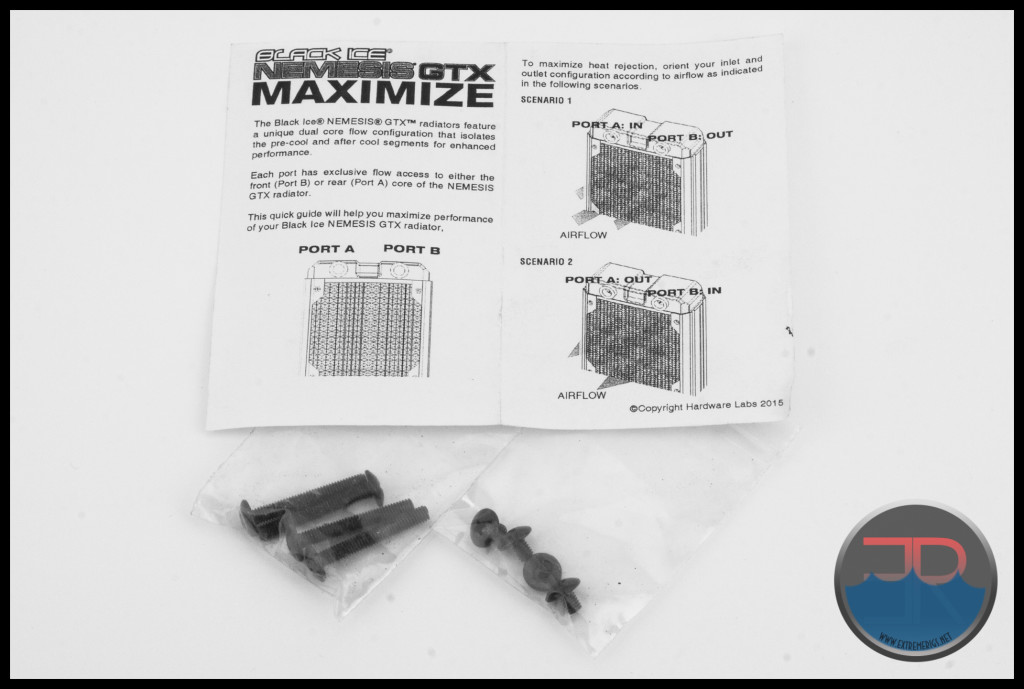
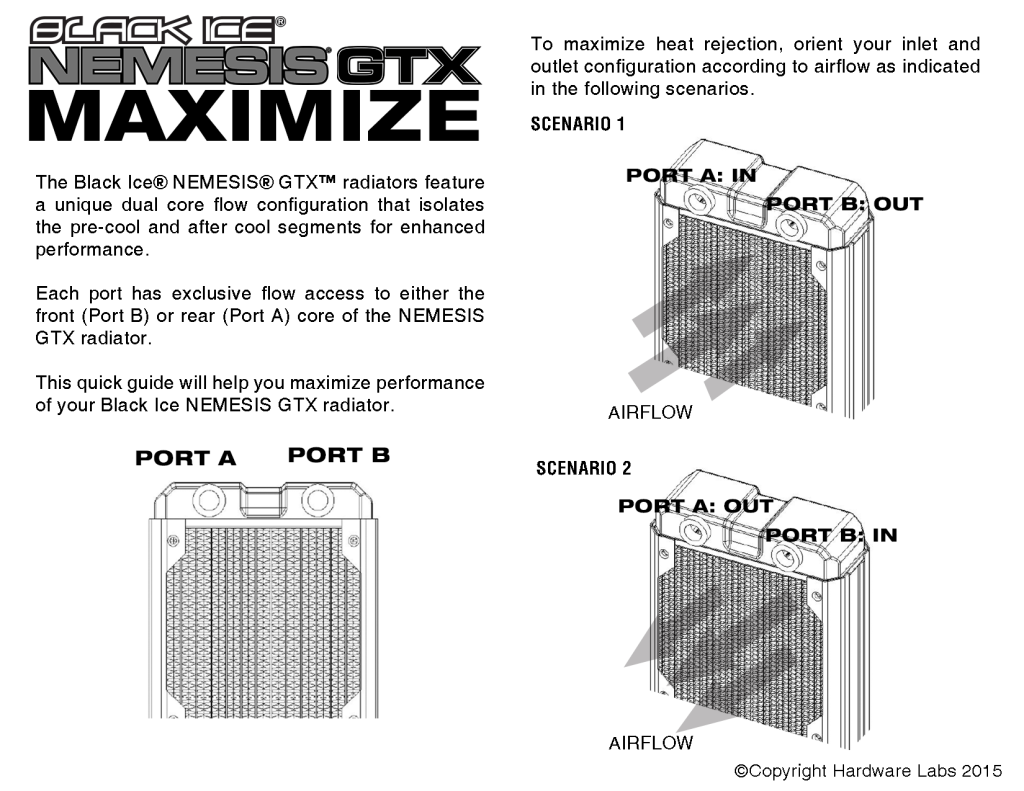
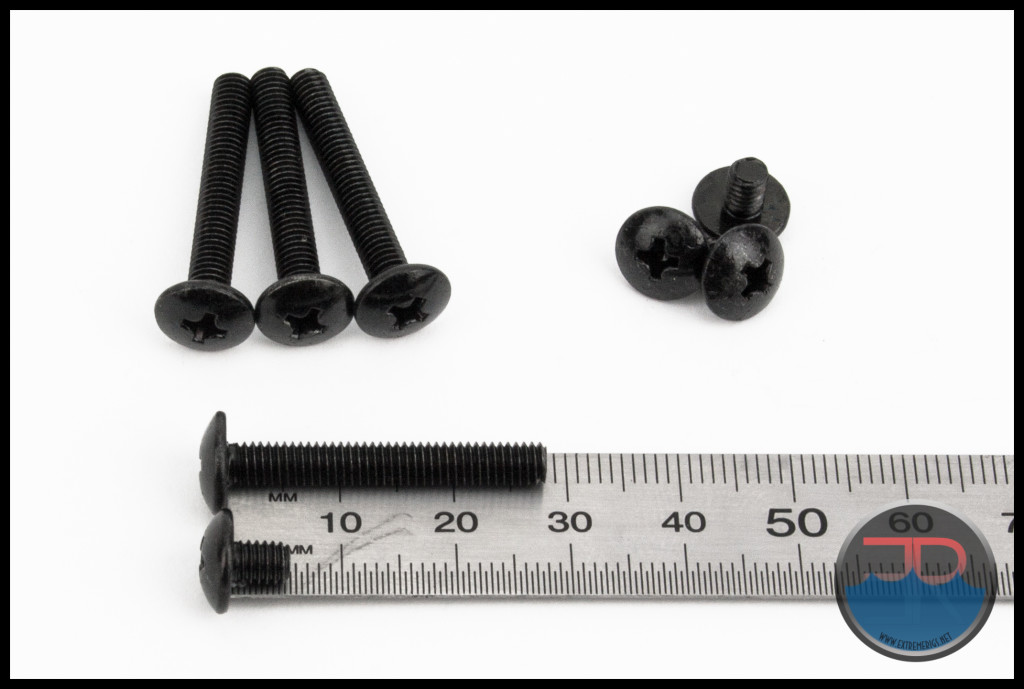
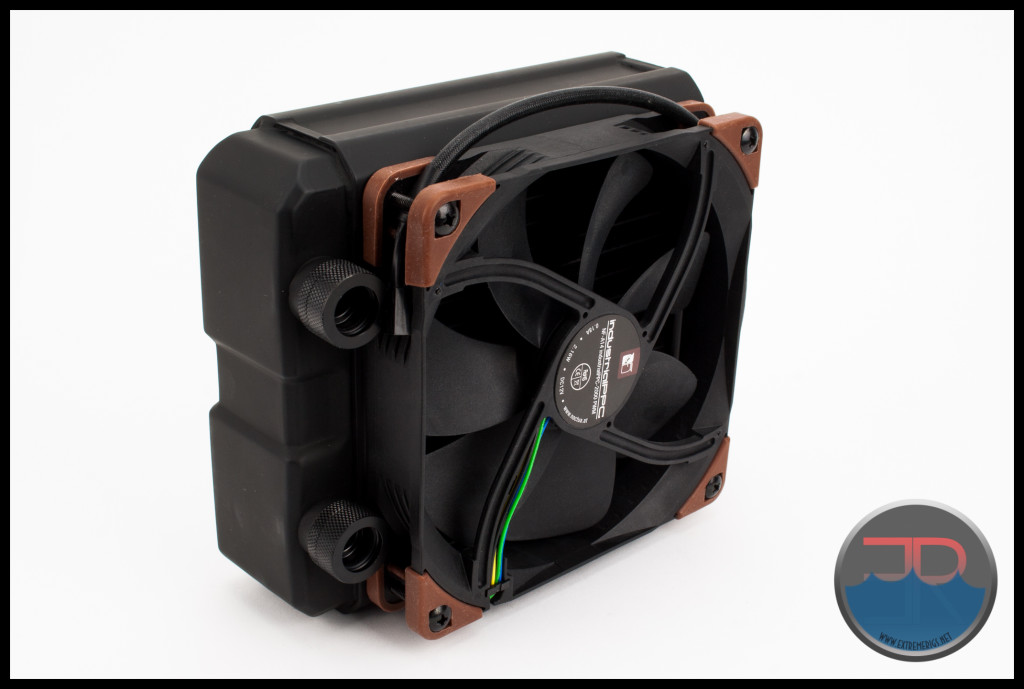


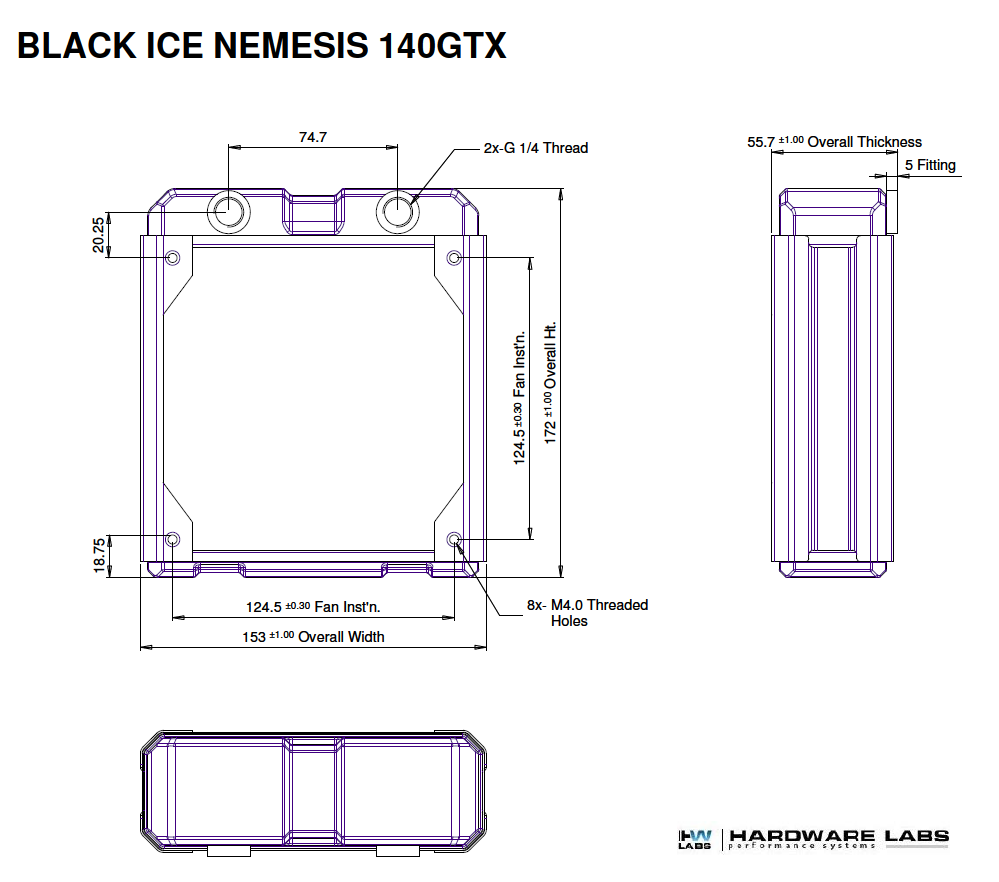
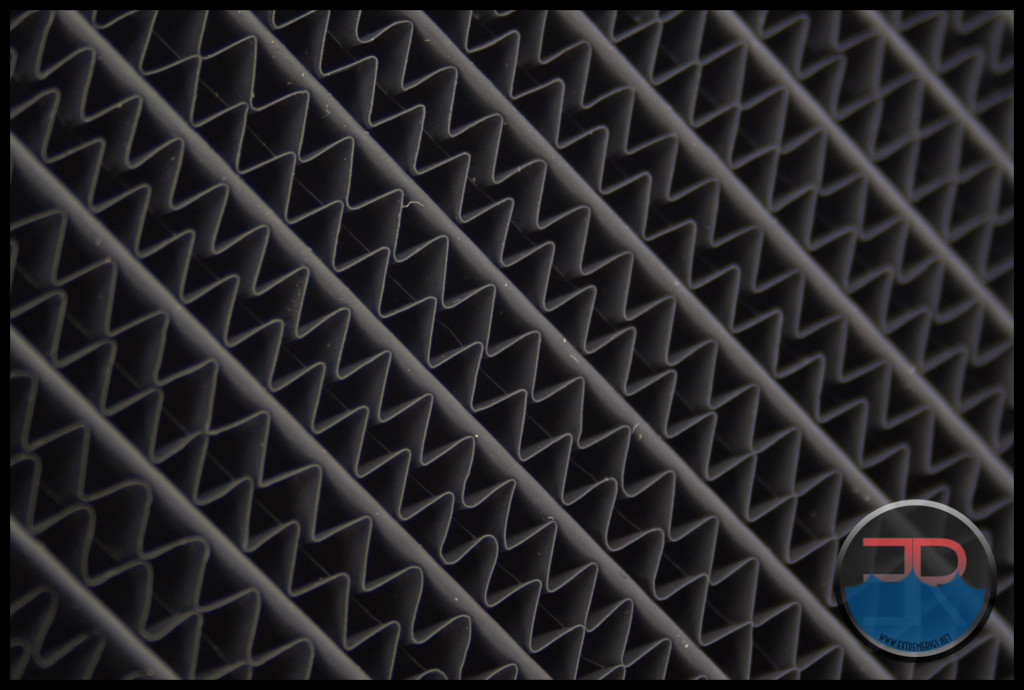
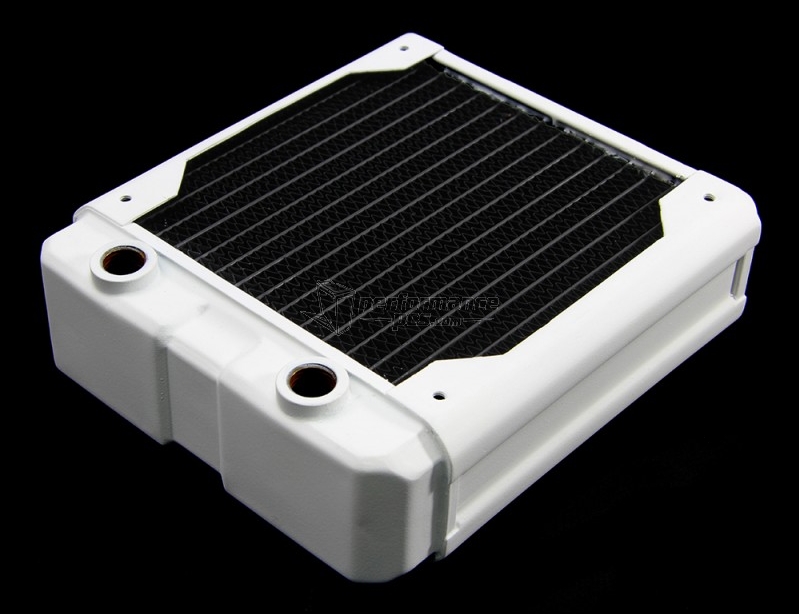
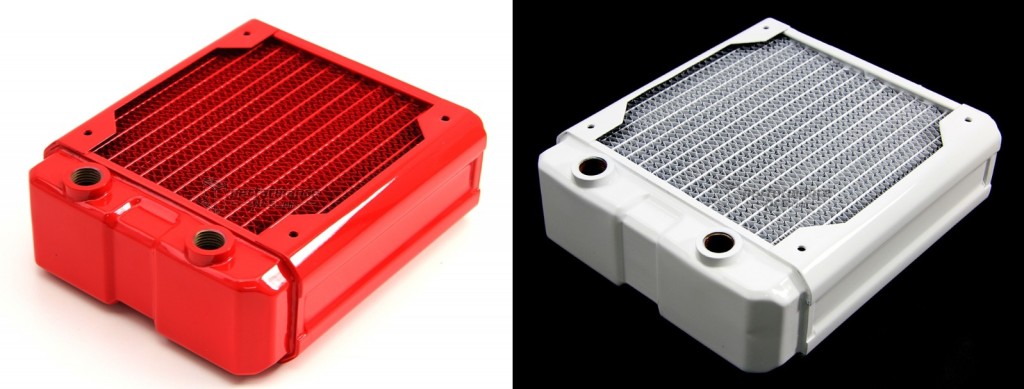
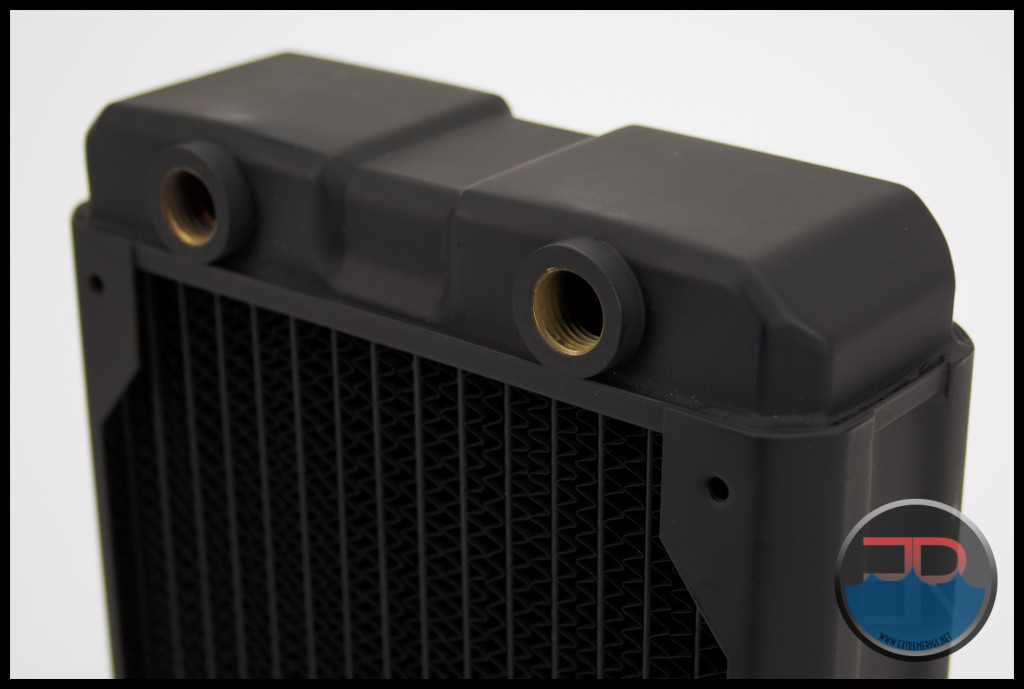
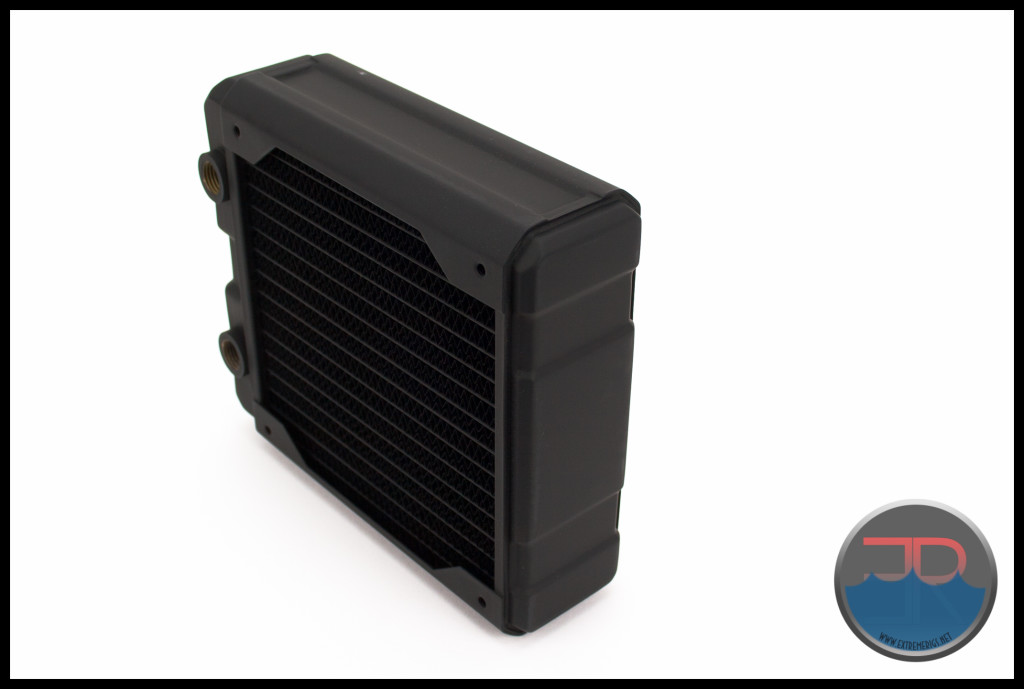
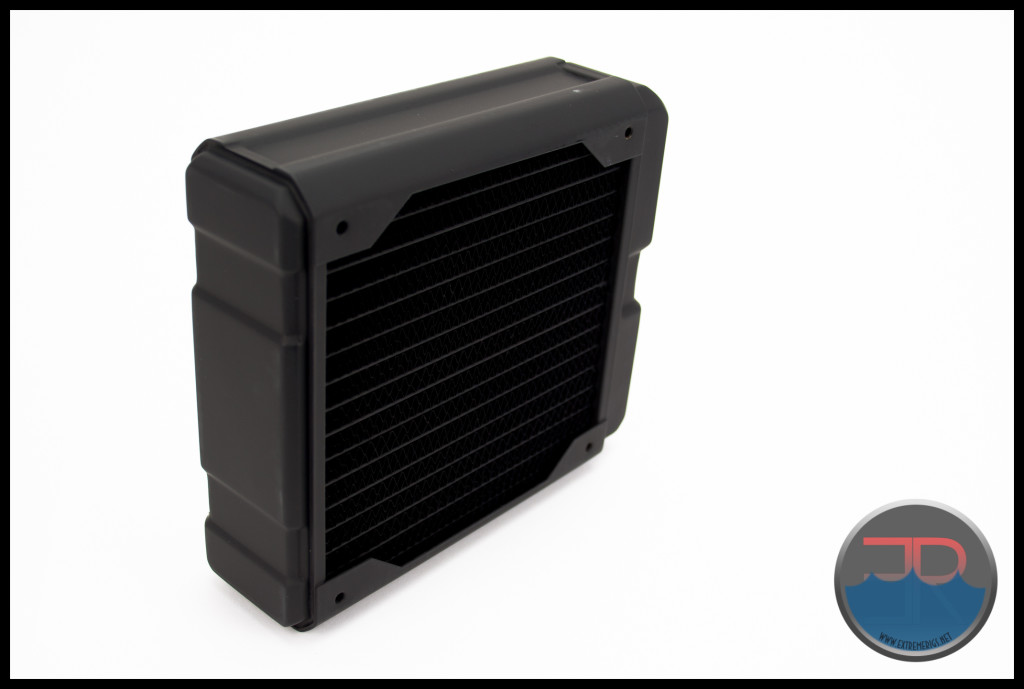
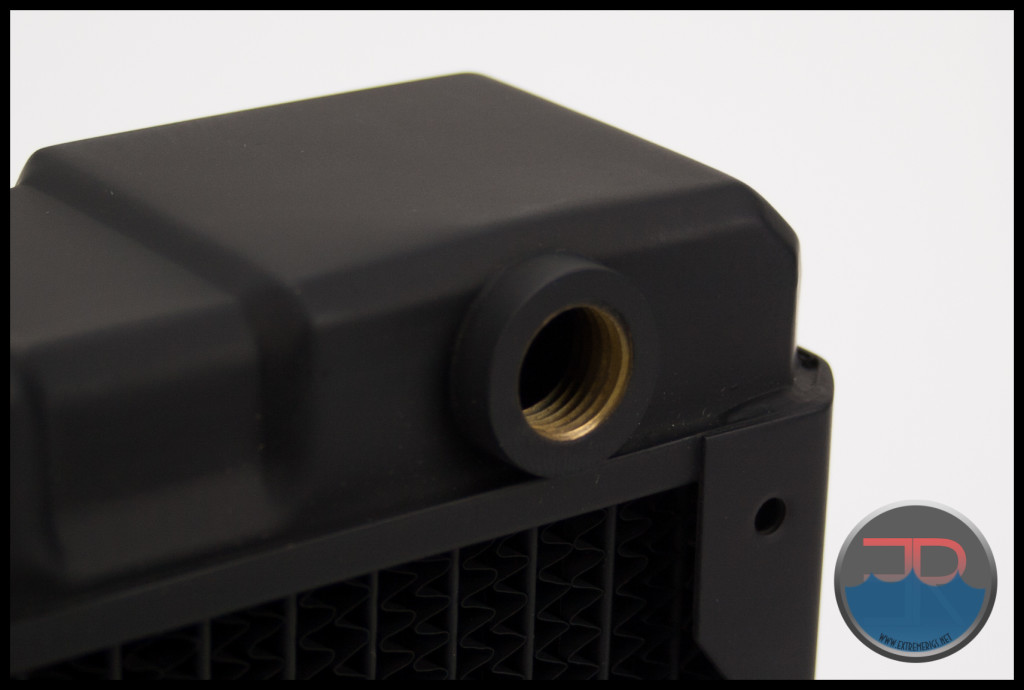
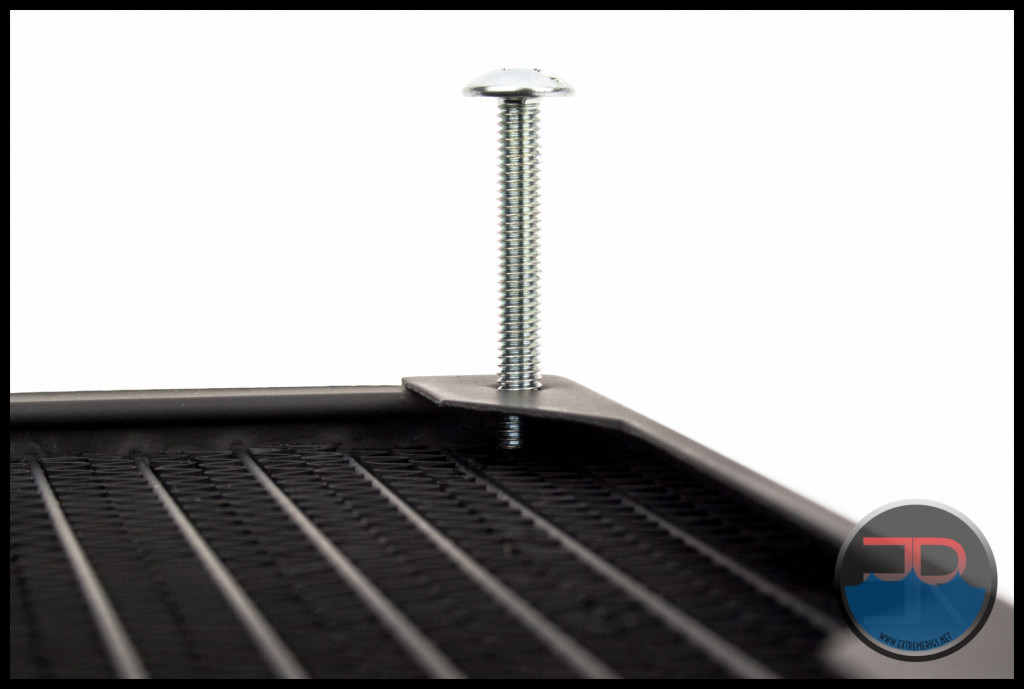
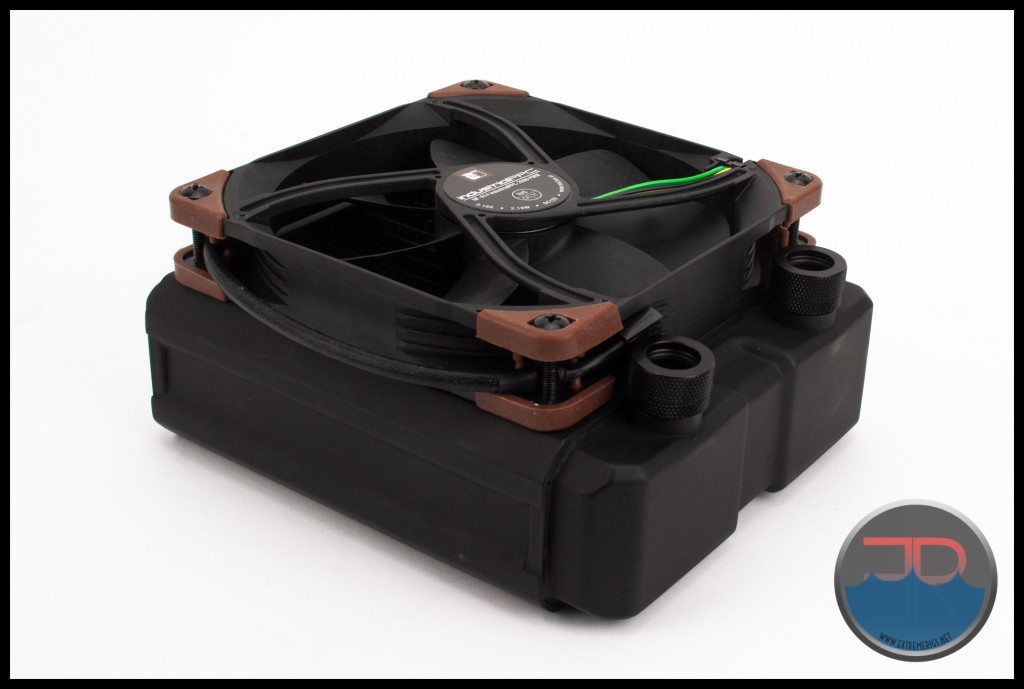
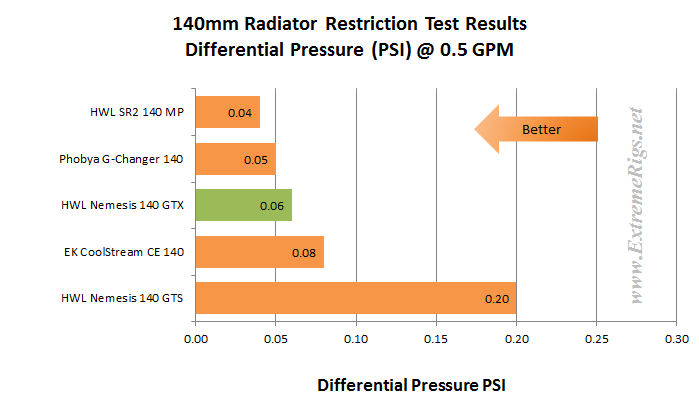
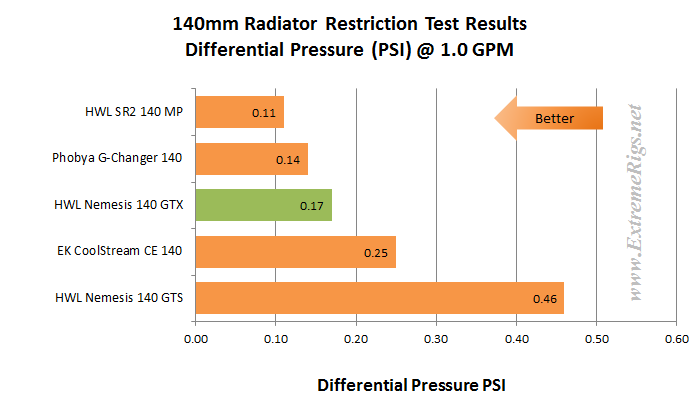
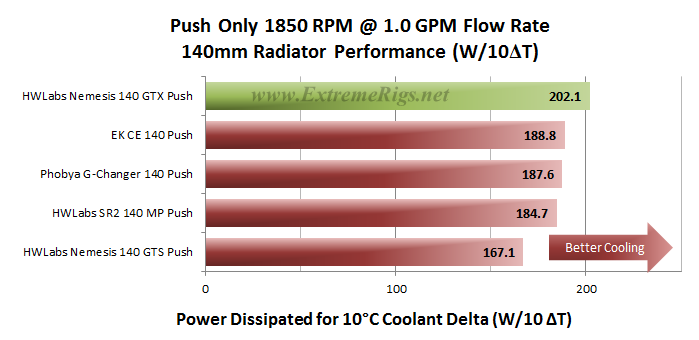
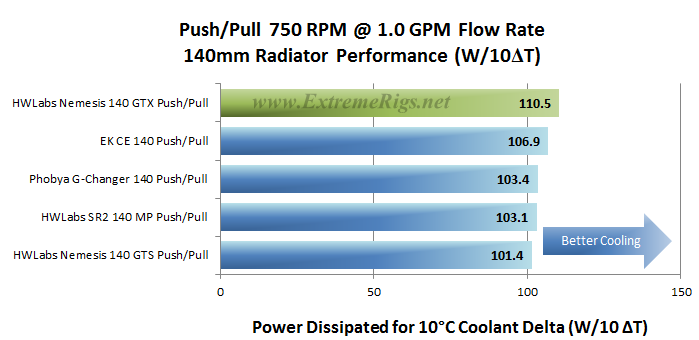
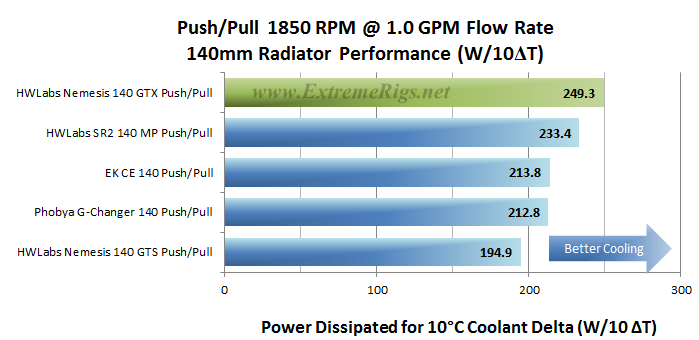
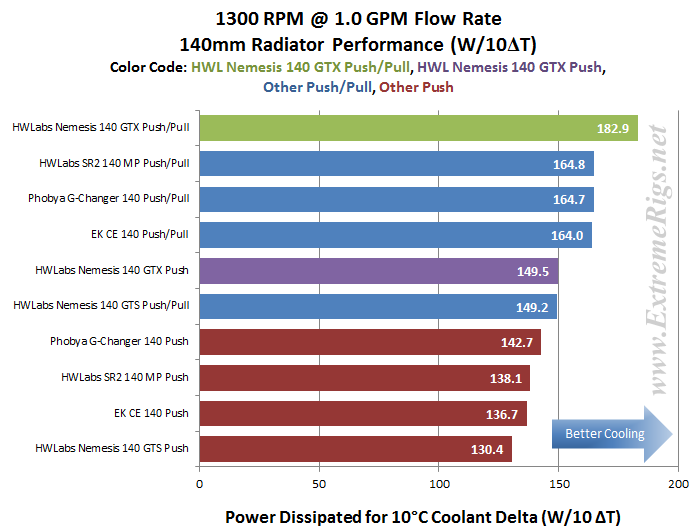
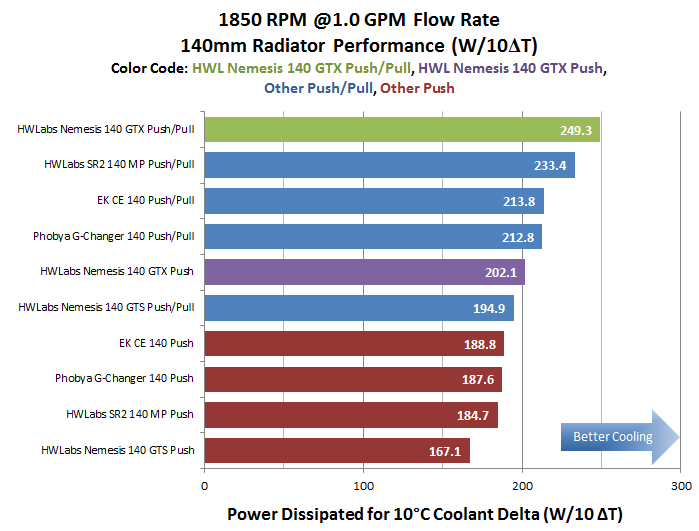
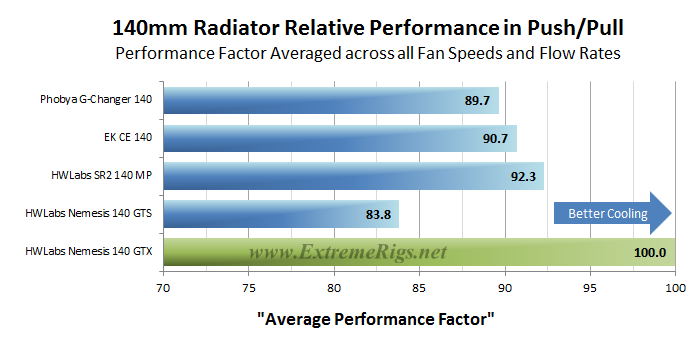
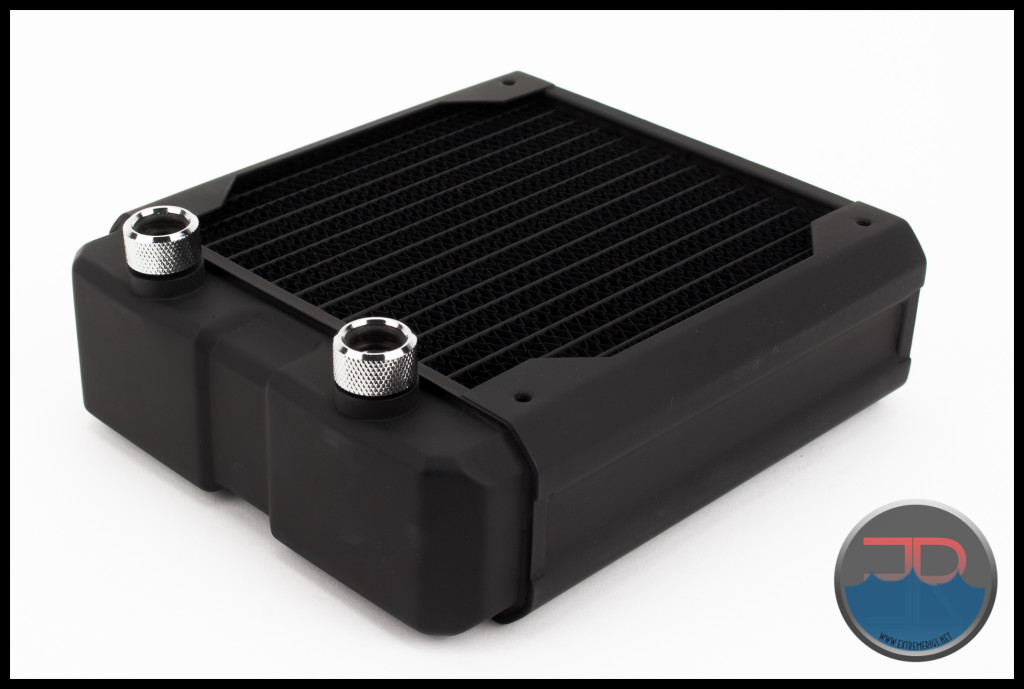

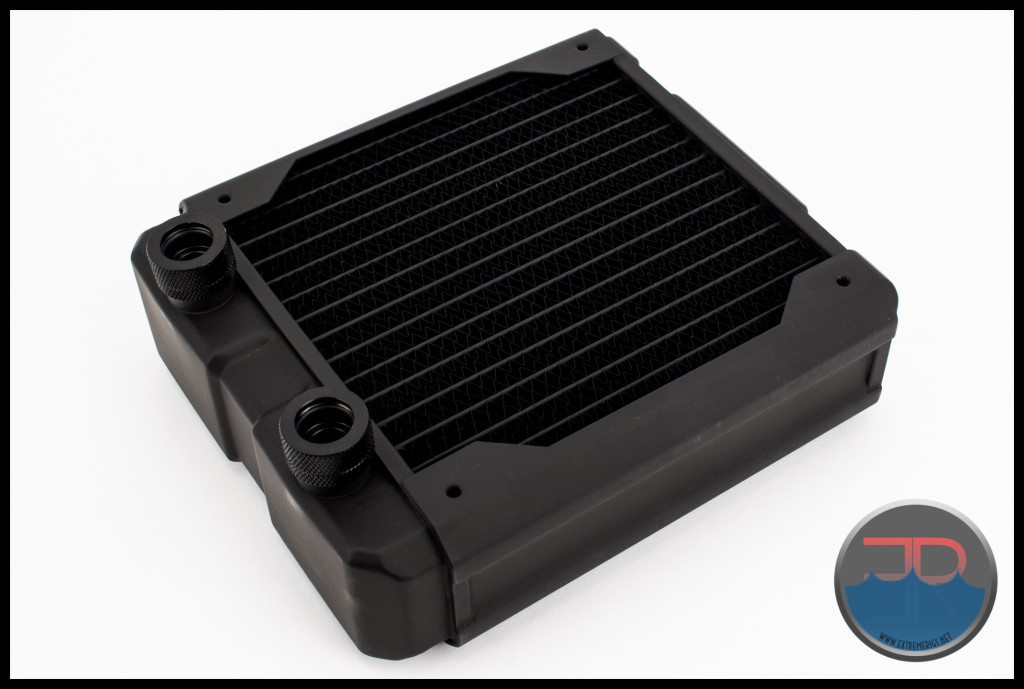



I really wish the 500rpm fan speed was tested with radiators on this site for lower noise builds. I’m trying to decide between a HWlabs GTX 140 and EK CE 140, and this extra data could push me off the fence either way.
In curious as to whether the GTXs performance would fall behind the CE in push pull at these fan speeds, since in the single fan configuration is is at the bottom of the 750rpm range.
The extrapolated plot makes it seems like the GTX would still beat the CE in push/pull: https://www.xtremerigs.net/wp-content/uploads/2015/11/140-W10DTPPvs.png
Sadly we can’t test every data point, to get this quality of data takes about a month per radiator so adding more data points just kills us!
Comments are closed.